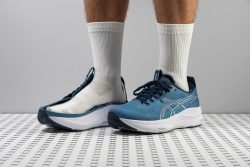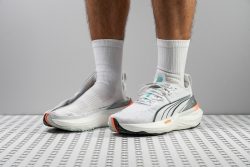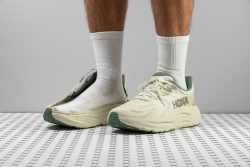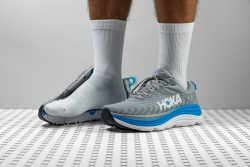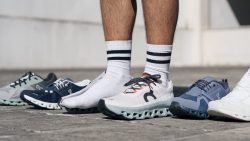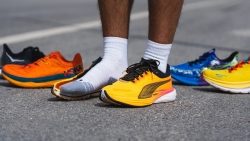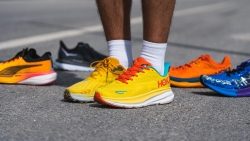7 Best Running Shoes For Overpronation in 2025

We buy shoes ourselves. We earn commissions when you buy through us, at no extra cost. Why trust us
The role of overpronation running shoes is to offer extra support which prevents excessive inward rolling of the foot. They help to lower the risk of injury and discomfort by using supportive elements on the inner side of the foot.
Given how crucial it is to your foot health, we were especially cautious when testing shoes for overpronation. All these models had gone through our lab tests and wear tests before we claimed the best ones.
We also presented our top picks in different categories, depending on what you may find the most important in your pair of shoes.
For more in-depth details on buying running shoes for overpronation, check out our guide that comes after the top picks!
Disclaimer: The purpose of this article is to educate, not to make any medical diagnosis or recommendation.
How we test running shoes for overpronation
Having runners with overpronation on our team, we understand first-hand how crucial it is to feel the best support you can get from a running shoe.
With the help of our shoe testing lab and an in-depth approach to the review process, we put each running shoe through the wringer:
- It is literally sliced into pieces in our lab and put through a series of tests that result in 30+ parameters, including ones that contribute to arch support and stability.
- We, as dedicated runners, log miles in overpronation running shoes before delivering our extensive feedback.
- We purchase all reviewed shoes with our own funds to escape any bias or brand loyalty.
You can expect to see the best running shoes for overpronation here.
Best running shoes for overpronation overall
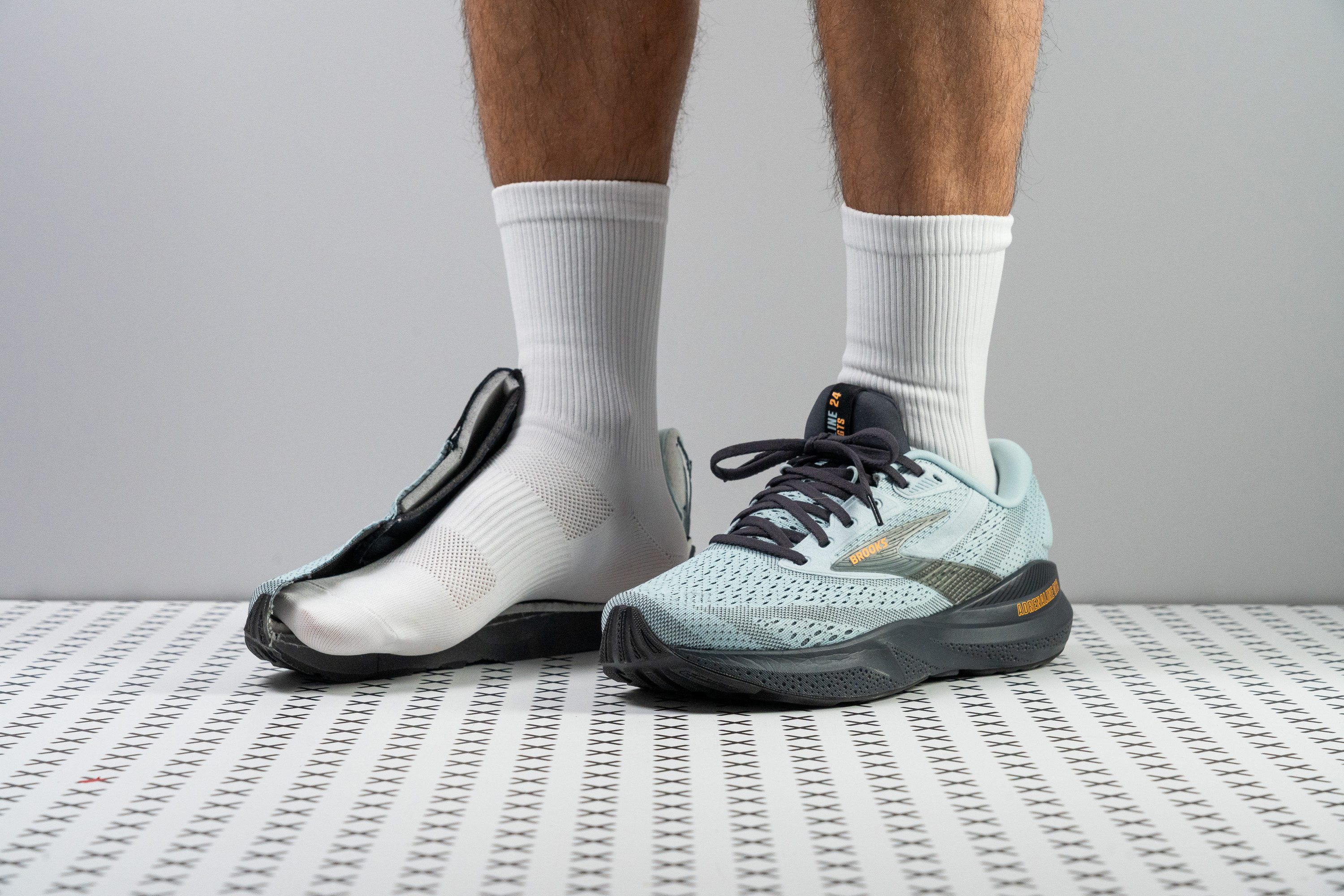
















































What makes it the best?
We believe overpronators seeking comfort and support have the Brooks Adrenaline GTS 24 as a top choice. It mixes rigid and gentle elements that make us feel so secure during our runs. Our lab tests show it features the brand’s GuideRails technology without stiffening the shoe’s build, and features a generous stack in the rear for cushioned landings.
Upon inspecting the shoe, we saw how the GuideRails extend to both sides of the shoe to keep our feet inside. Embracing us firmly, it feels impossible to do excessive pronation since our feet remain centered. In addition, the midsole features a medial post to add reinforcements for our arches.
The cushion also delivers a springy and stable ride through its firm 25.1 HA foam. To boost comfort, the heel has a thick 39.0 mm stack to mute out harsh and heavy landings.
What also enhanced comfort is the shoe’s flexibility. While most stability shoes are rigid, GTS 24 emerged 19.9% more flexible than the average running shoe, making it easy on the feet during longer runs.
However, its steep 13.5 mm offset may be a dealbreaker for some. We recommend midfoot and forefoot strikers to find a pair with a lower drop.
Pros
- Stack height upgrade!
- Reliable support
- Breathable mesh with oversized vents
- Price remains unchanged
- Available in 4 width options
- Good durability
- Plush tongue for top comfort
- Ideal for heel strikers
- Foam upgrade to DNA Loft v3
Cons
- Firmer-than-expected midsole
- High drop may feel too steep
- Toebox height is a bit low
- Non-gusseted tongue
Running shoes for overpronation with the best shock absorption














































What makes it the best?
After conducting outdoor runs and lab tests, we have concluded the ASICS Gel Kayano 32 has the best shock absorption for overpronators. With subtle yet effective stability features, top-tier comfort, and superb traction, it’s hard to match its supportive ride.
Our runs were much more enjoyable with GK32’s tall and leg-saving stack. Testing for shock absorption, the heel returned a high 133 SA score, confirming the coziness we felt. Moreover, it reaches a massive height of 39.9 mm vs. the 34.4 mm average for added comfort.
Contrary to most maximalists, GK32 is highly stable thanks to its reliable support system: composed of the mind-blowing 4D Guidance system, midsole sidewalls, and expansive landing platform, to name a few. The shoe adapts to our foot shape with further use, providing the support needed by every unique individual. Our caliper also reveals the massive 119.8/97.2 mm midsole that secures our landings.
Another element that boosts confidence is its grippy outsole. In our traction test, it returned a 0.84 friction score, one of the highest we’ve ever seen. This rating proves its reliability on wet and dry surfaces.
However, our scales confirmed what we expected: the GK32 is heavy at 10.4 oz (295g). Those who prioritize agility should look elsewhere.
Pros
- Amazing shock absorption
- Plush and breathable upper
- Made to last
- Dependable for most pronators
- Heavy-duty outsole with excellent grip
- Stable as a table
- Pillow-soft heel padding
- Improved fit
- Excellent build quality
Cons
- Not for soft-foam lovers
- Bad energy return
- Overpriced in Europe
Running shoes for overpronation with the best energy return
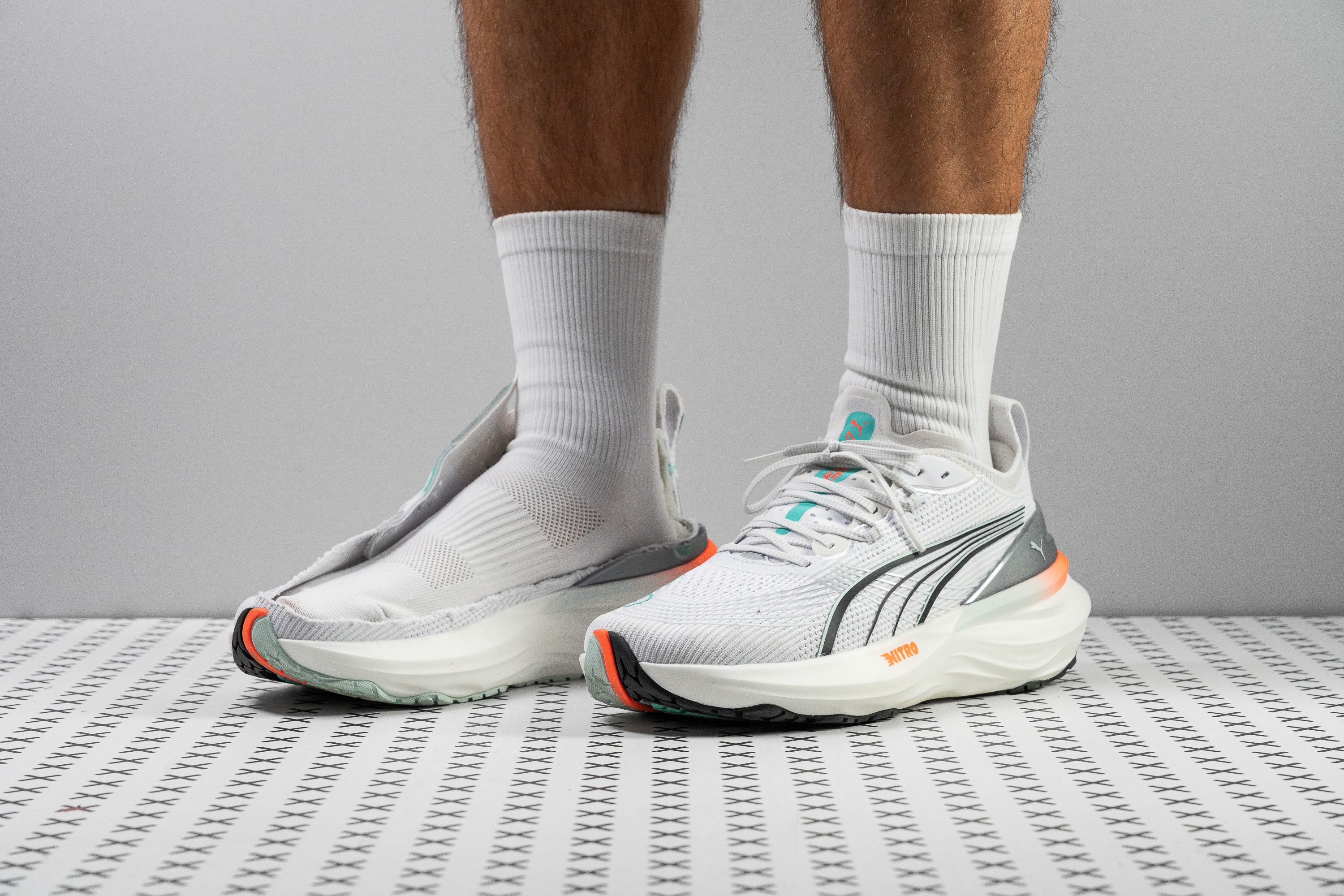











































What makes it the best?
Countless hours on foot and in the lab led us to the running shoe with the best energy return for overpronators, and it’s none other than the PUMA ForeverRun Nitro 2. Featuring the Nitro foam and the PumaGrip rubber, it allowed us to run through various street conditions without any dullness or worries. Its steady support adds to our confidence, while its flexible midsole makes it forgiving for daily use.
Testing for its responsiveness, the Nitro foam impressed with high ratings of 60.5% in the heel and 63.6% in the forefoot. For a stability trainer, these figures are remarkable!
ForeverRun Nitro 2’s support is straightforward and effective, featuring the Run Guide System, which is a plastic insert that secures the heel. On foot, we could feel that it prevents lateral movement.
In our traction test, the PumaGrip rubber emerged with a high friction coefficient of 0.63, making it 34.0% grippier than average! Besides the tacky compound, the outsole design includes wavy lugs for enhanced control. The central part has exposed foam to reduce weight, yet PUMA reinforces the inner midfoot for extra durability for overpronators.
Thankfully, the midsole has lots of room to bend forward. In our flex test, it even emerged 28.9% more pliable than average, making it comfortable for daily use.
However, users who appreciated the first version’s light build will be disappointed in the second version’s weight gain. At 10.3 oz (291g), this shoe is 9.8% heavier than average.
Pros
- Breathable and comfortable knit upper
- Amazing traction with PumaGrip
- Fair price for its features
- Excellent stability
- Flexible build
- Good durability
- Well designed for heel strikers
- Extra-wide midsole for added support
- Good option for everyday life too
Cons
- Heavier than the previous version
- Rocker mainly benefits heel strikers
- Stability system could be a bit intrusive
- Not the best for wide feet
Best daily running shoes for overpronation
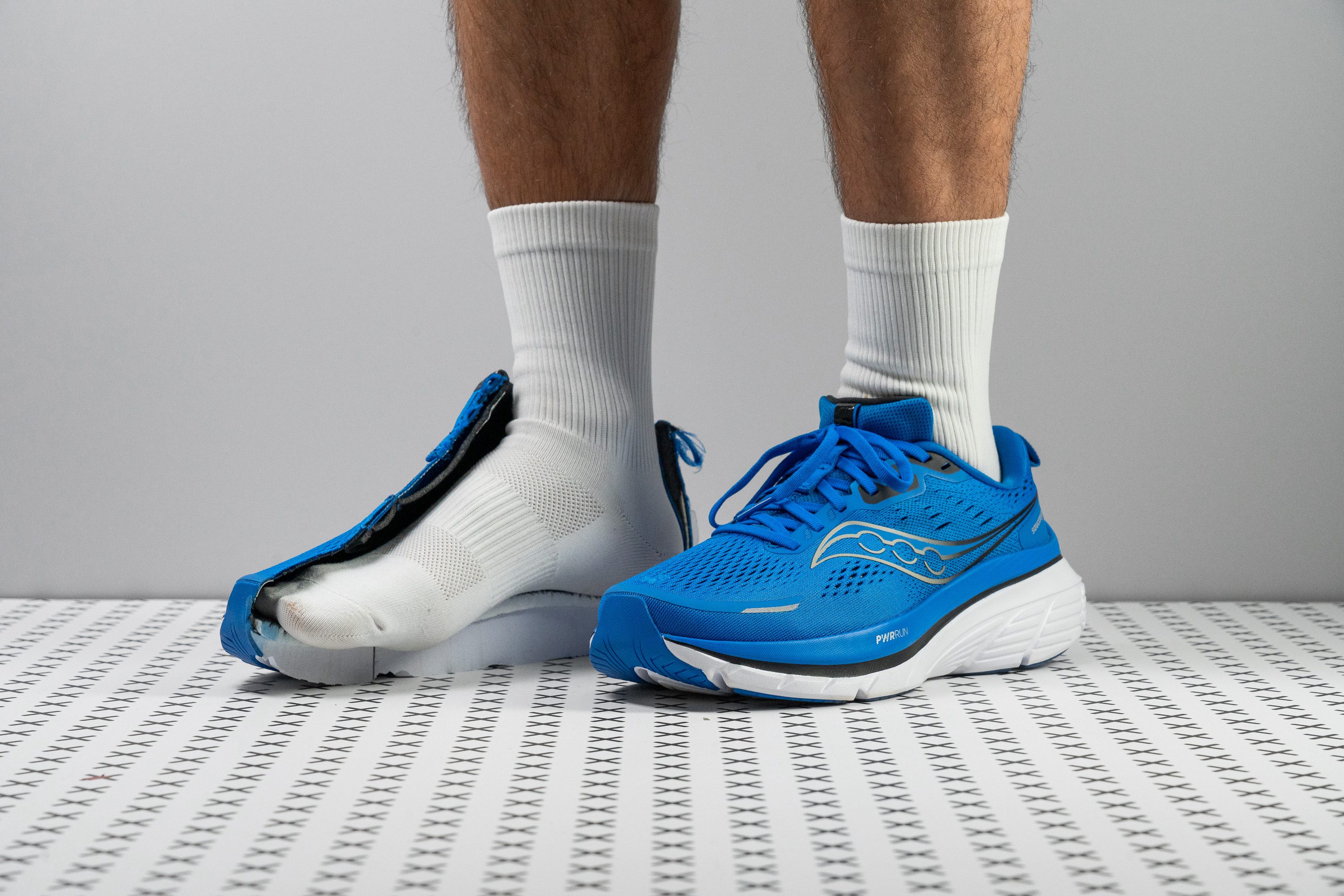















































What makes it the best?
Meeting the everyday needs of overpronators, Saucony Guide 18 hits the sweet spot of a daily trainer, providing comfort and guidance in a light, breathable package. Our lab results can attest it defies the traditional stability shoe by offering gentle support for any distance and footstrike.
Unlike most supportive shoes, Guide 18 is easy on the feet as the miles go by. Our scales reveal a mere 9.8 oz (278g) vs. the 10.1 oz (286g) average stability shoe, delivering a fresh and burden-free ride. The shoe feels nowhere near restrictive—as our bend test confirms its loose feel, emerging 8.9% more flexible than average. Plus, its exceptionally breathable upper adds to its weightlessness.
We felt empowered to chase extra miles than planned with its generous stack that dampened landing impact. Our caliper reveals a height of 36.0/27.7 mm, which feels highly cushioned for any footstrike. A balanced midsole sits underfoot to enhance our surefootedness, as confirmed by our 23.0 HA durometer measurement.
A network of stability mechanisms intertwines within the shoe, harmoniously guiding our feet along the correct path. The rocker pushes us forward, the midsole walls and heel flare keep us centered, while the extra wide 121.9/105.0 mm midsole secures our landings.
While weightless, the Guide 18 lacks the spark of a speedy trainer. Overpronators seeking a swift workhorse to handle intense sessions can explore elsewhere.
Pros
- Upper now has exceptional breathability
- Stable yet non-restrictive ride
- Cushioned enough for long runs
- Handles walking too
- Impressively wide platform
- PWRRUN PB insole
- Secure and comfortable lockdown
- Excellent heel rocker design
Cons
- Too much exposed foam on outsole
- Feels bulky and not agile
- Midsole runs a bit firm
Best lightweight running shoes for overpronation
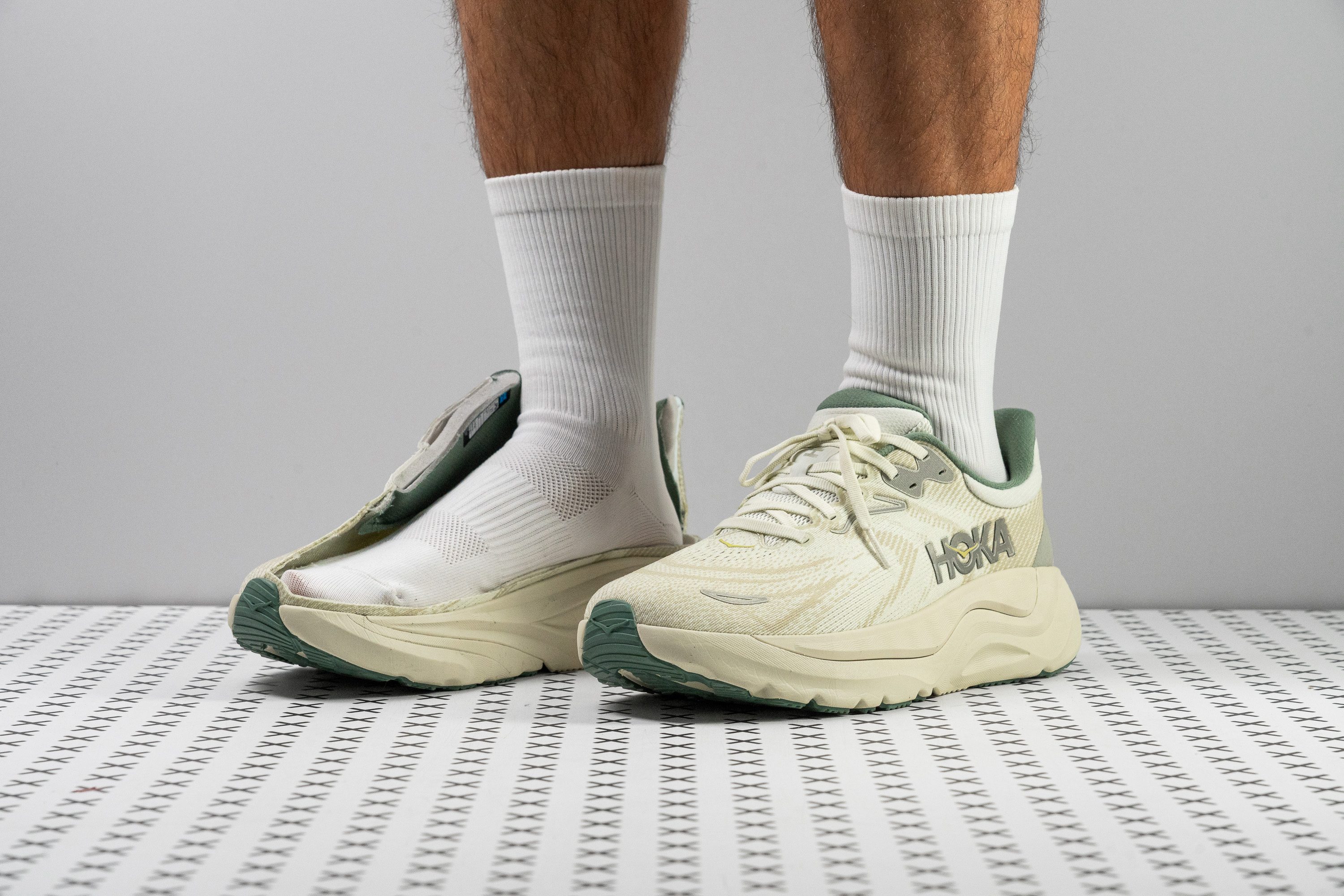











































What makes it the best?
Infused with stability in a minimal package, the Hoka Arahi 8 stands out as the best lightweight overpronation running shoe in our lab assessments and runs. It offers great support through its H-Frame, while balancing the ride with softness and impact protection.
To put a figure on the airiness we felt, Arahi 8 only weighs 9.1 oz (259g), much lighter than typical stability shoes because it manages to stay under the 9.3 oz (265g) average neutral and stability running shoe!
Hoka’s H-Frame consists of firmer foam to prevent excessive lateral movement, which is reflected in Arahi 8’s maximum 5/5 torsional rigidity rating in our manual twist test. Because it’s so effective, it can manage to improve its cushioning.
Measuring its stack height, it rises above average at 39.4/28.1 mm, offering long-distance comfort. Plus, it delivers exceptional joint protection, evidenced by high shock absorption scores of 138 SA in the heel and 113 SA in the forefoot.
Unlike its weight, it unfortunately doesn’t feel so airy in the toebox. When the temperature starts to rise, the heat and sweat start to build up. Runners who prefer a breathable shoe should skip this pair.
Pros
- Impressively lightweight for its size
- Strong shock absorption
- Wider fit than previous versions
- Outstanding durability across upper and outsole
- Early-Stage Meta Rocker smooths transitions
- Higher drop suits better heel strikers
- Comfy and plush for everyday use
- H-Frame stability system
- Comfortable heel counter
Cons
- Very poor breathability
- Grip needs to improve
- Still no supercritical foam
- Minor price bump
Best overpronation running shoes for long distance
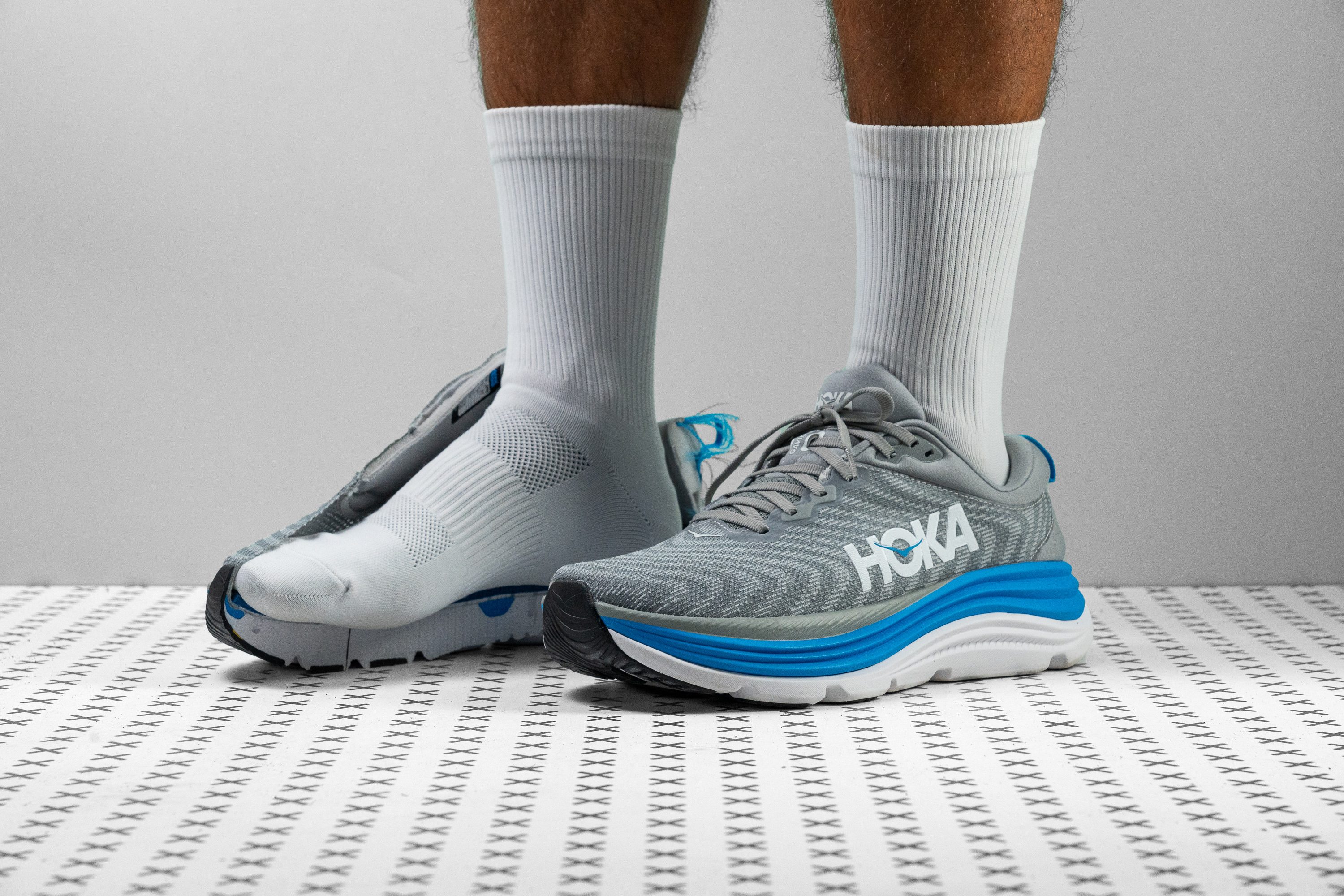
















































What makes it the best?
When it comes to the best long-distance shoe for overpronators, the Gaviota 5 is truly second to none. Its pillowy soft and protective cushioning had us soaring for miles on end, just like the seagulls the shoe is named after.
Ground-feel? What’s that? Sitting on a substantial stack that measures 34.9 mm at the heel and 32.7 mm at the forefoot, the Gaviota 5’s midsole is higher than the average shoe by 1.5 mm and 8.2 mm, respectively. What’s more, our durometer reveals the midsole foam to be 46% softer than average with a positively plush reading of 12.9 HA. This combination means that we barely felt the repeated impact against the asphalt during our test runs, with a lofty ride that feels akin to bouncing on clouds.
A high stack of plush foam seems counterintuitive for stability, but the sheer width of the midsole effectively offsets any tippiness we expected to feel in the shoe. Measuring a gargantuan 125.1 mm wide at the forefoot, the Gaviota 5 boasts a base 12 mm wider than the average road shoe. This means that forefoot striking runners will have plenty of platform to feel surefooted from landing to toe-off.
Heel-striking runners will also enjoy steady landings in this shoe, with a midsole that’s a whopping 16 mm wider than average at the heel, according to our caliper. However, the Gaviota 5’s super-low 2.2 mm drop definitely makes it more geared towards forefoot strikers.
Pros
- Remarkably stable
- Breathable and comfortable upper
- Lightweight for its size
- Good stability option for forefoot strikers
- Ideal for wide feet
- Excellent for long runs
Cons
- Low drop might pose issues for heel strikers
- Performs poorly in colder conditions
- Not for narrow feet
- Midsole feels flat
Best budget running shoes for overpronation
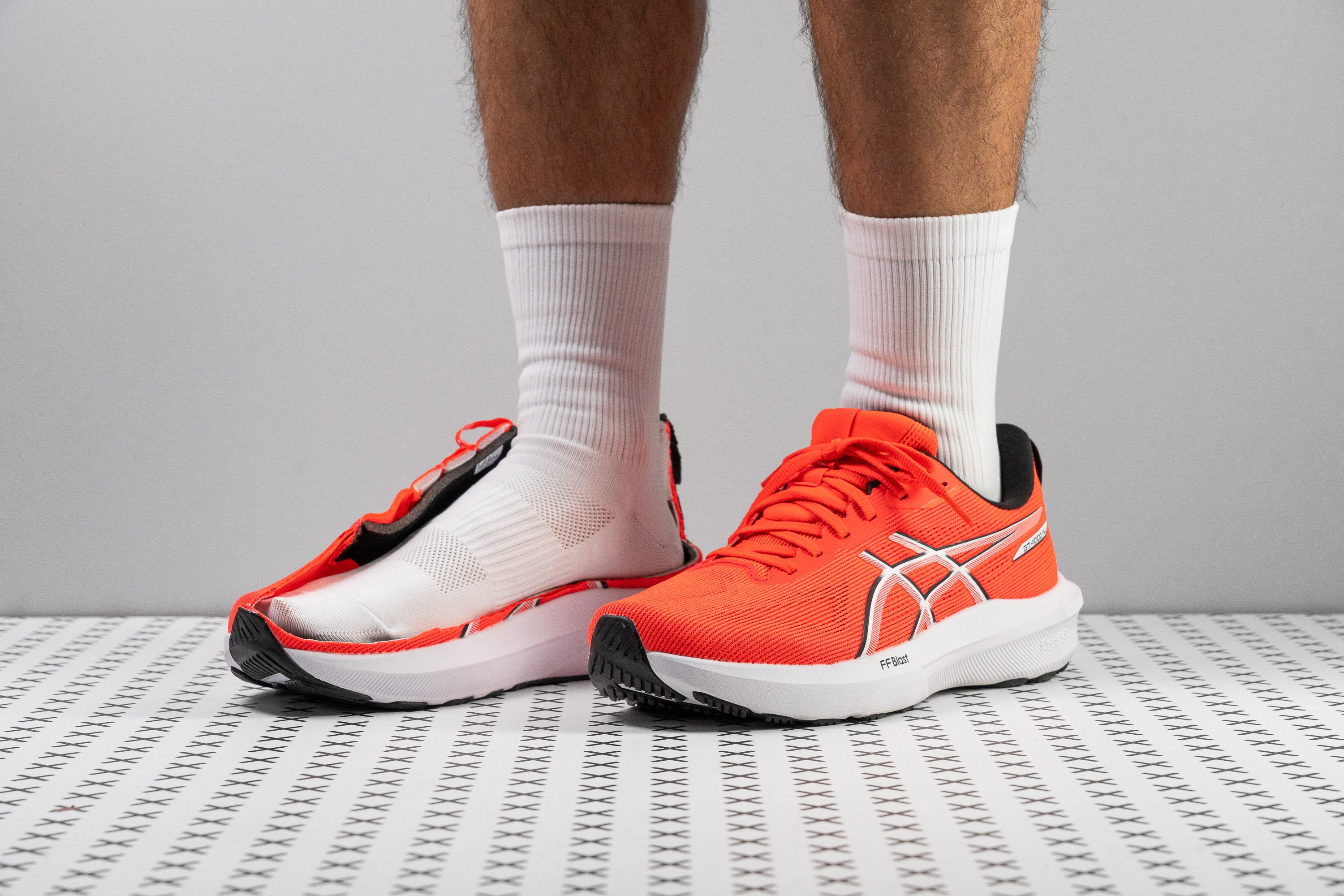













































What makes it the best?
In our runs, we found that ASICS GT 1000 14 is tailor-made for overpronators—beating its counterparts by blending stability and comfort without breaking the bank. It’s built to last, and for $110, it is our best budget overpronation running shoe compared to other stability shoes that average $142.
GT 1000 14 offers reliable support through the 3D Guidance System, composed of midsole sidewalls, a stiffer arch, and a broad 94.8 mm heel. All these elements work together to direct our motions forward. It’s highly twist-resistant, proven by its 4/5 torsional rigidity score.
Unlike most rigid stability shoes, this pair has a loose and unresisting build for foot-bending— highlighting comfort and versatility. Our flex test confirms the shoe is 19.1% more flexible than average. Adding comfort to our runs is the airy build of the shoe. It boasts a light 9.6 oz (271g), while most stability shoes weigh above 10.0 oz (283g).
The outsole delivers all-weather traction, yet stands out for its wear resistance. Showing 30.0% less damage than average in our Dremel test, it excels in durability, making its accessible price even more worth it.
While this shoe performs on most runs, speed enthusiasts might feel underwhelmed by the midsole’s lack of energy. Overpronators who want to go faster should invest in a more responsive shoe.
Pros
- Supercharged stability
- Ideal for heel strikers
- Still offers amazing value
- Fuss-free, durable design
- Improved outsole traction
- Comfortable for everyday wear
- Great step-in feel
- Improved foam from v13
Cons
- Bad breathability
- Still lacks energy return
- Boring ride
Do you need overpronation running shoes
Yes, if you overpronate.
While novice runners might use neutral shoes as shown in this study, research (here and here) has shown that overpronators benefit from using overpronation running shoes - these shoes improve rearfoot eversion and lower the injury risk.
To find out if you overpronate and at which level, it's best to schedule an appointment with a specialist (biomechanics, orthopedist, and similar).
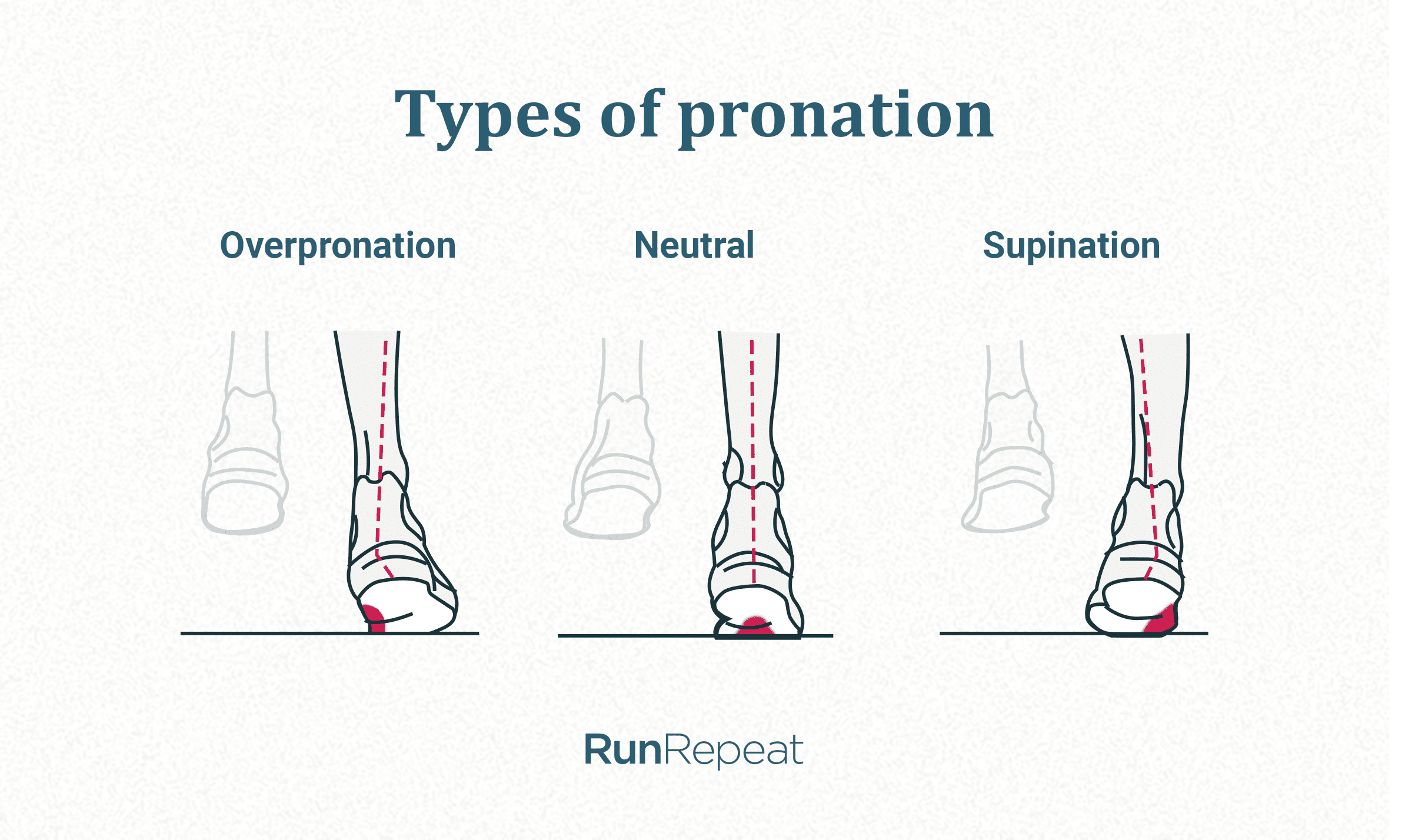
If you can't do that, consult the visual guide below but keep in mind that these DIY tests are of much lower accuracy than the tests and assessments performed by a specialist.
You can video your movement (from behind) or visually inspect your footwear that has seen significant mileage already.
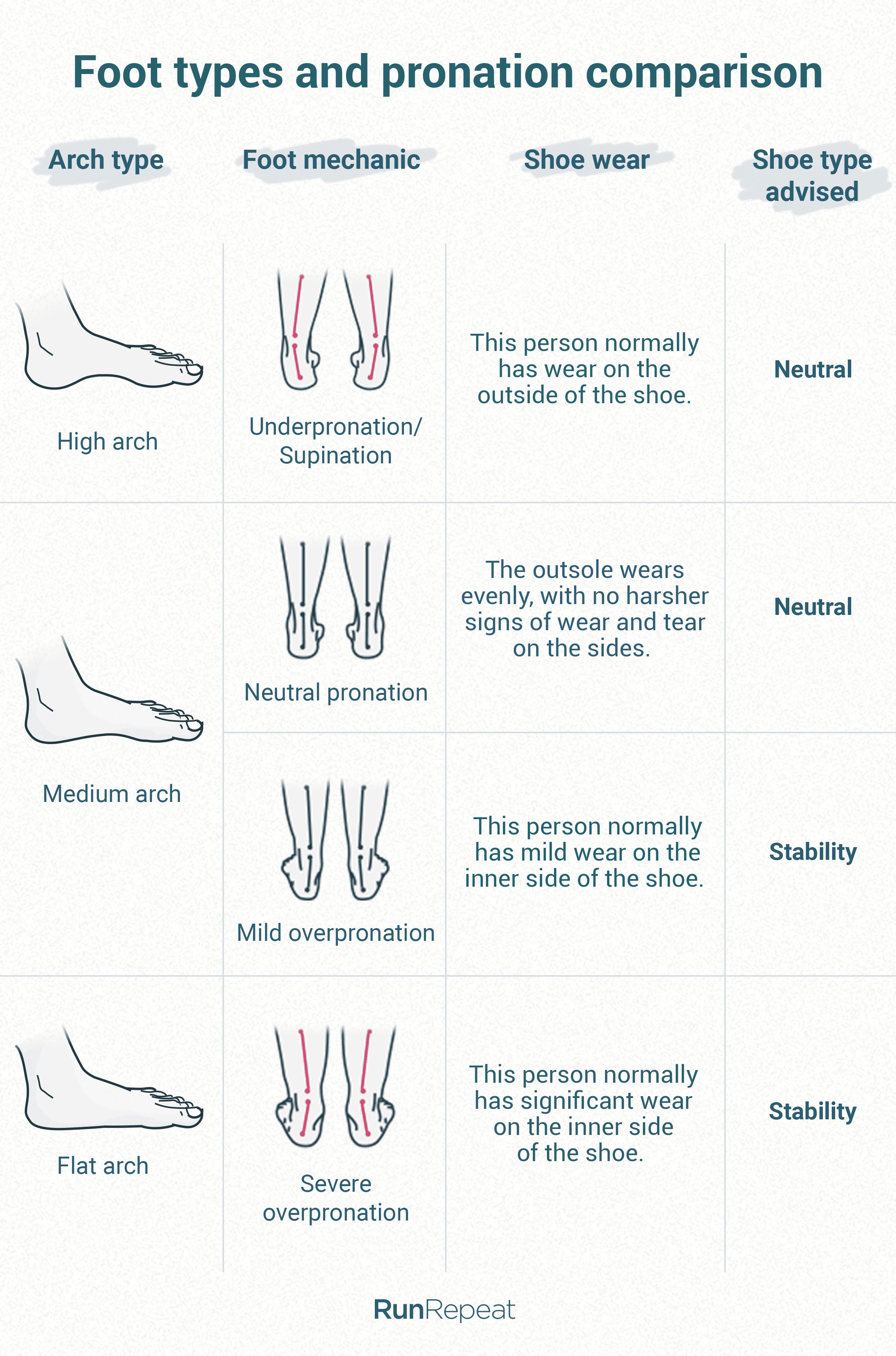
- For mild overpronation, both stable neutral shoes and stability shoes are good options
- For moderate overpronation, stability shoes are recommended
- For severe overpronation, it's best to consult a specialist. Runners often use custom-made orthotics, stability shoes, or even motion-control shoes. But, with the new technologies, motion control shoes are made less and modern stability shoes are replacing them.
When overpronating, impact distribution isn’t even throughout the foot during ground-time, so it might lay ground for injuries like shin splints or plantar fasciitis. That’s why it’s important to choose shoes that match your running gait.
Wet test: discover your arch type
If you’re insecure about the above-mentioned methodology, you can also do a so-called wet test to discover the type of your arches.
Here’s how:
- Wet the soles of your feet, one at a time
- Stand onto a piece of paper while allowing the water from your feet to sink into the paper
- Step off
- Look at the shape of your footprint and compare it to the ones shown below.

If your footprints look like the 1st picture, you should look into motion-control running shoes or stability running shoes. People with medium and high arches usually run in neutral running shoes.
These guidelines are general and don’t apply to 100% of cases. Scientists still think that, when picking a running shoe, comfort comes first. If you have a history of injuries or experience severe pain during the run, consult a specialist.
| If you want to dig deeper into this topic, we wholeheartedly recommend our in-depth guide Pronation 101: Running Shoe Choices, DIY Analysis, Injuries. |
How to recognize overpronation running shoes
If you want to judge the shoe “in person”, you should: try to bend it, twist it, look at the outsole, and squeeze the heel counter. Running shoes for overpronation tend to have a stiff base, stiff heel counter, outsole that allows for a lot of ground contact, and can include other (trademarked or not) technologies that stabilize the foot when hitting the ground.
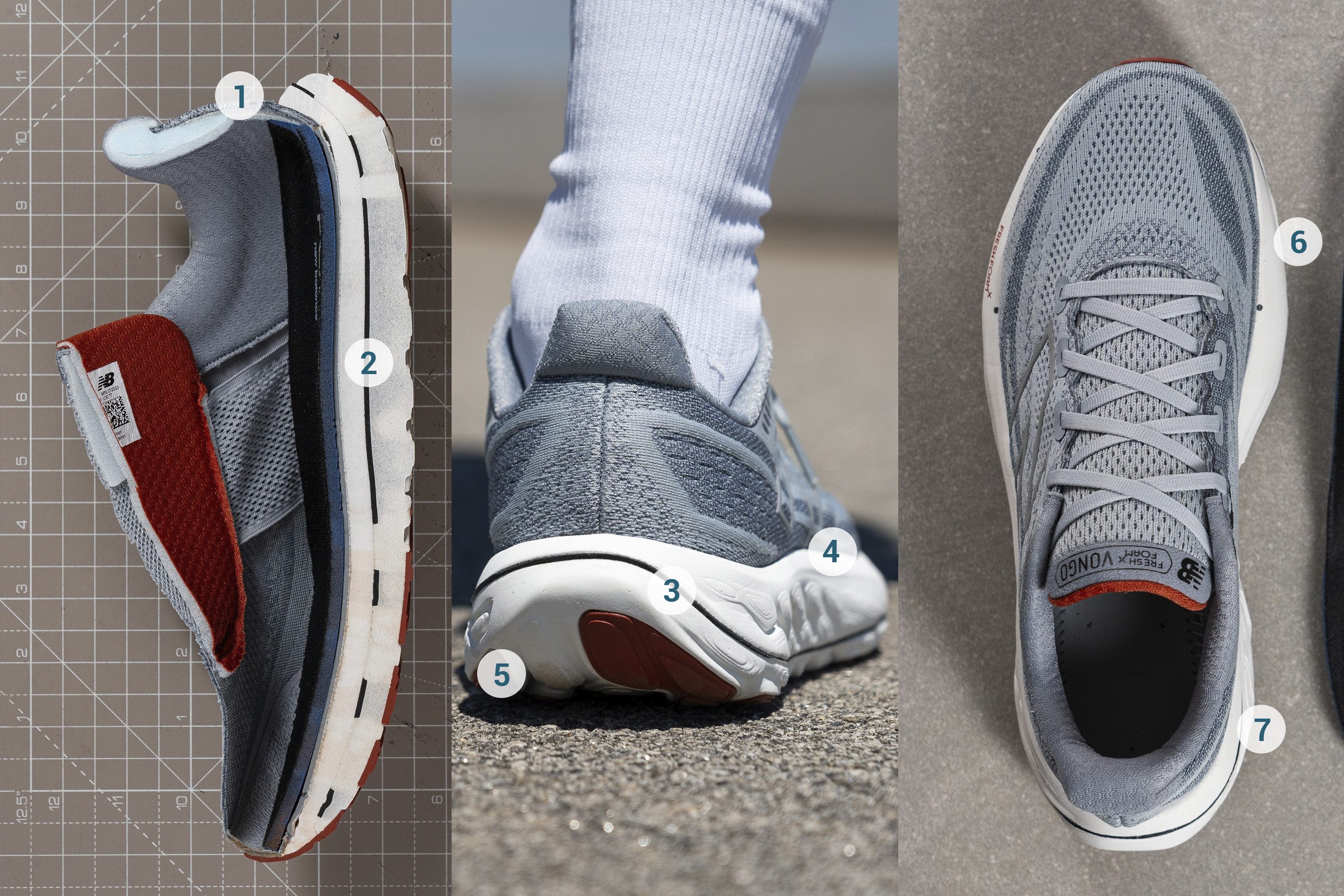
It's also important to note that overpronators need less stability at faster paces. This is because the ground contact is shorter when we run races or speed sessions. Because of this, tempo shoes and competition shoes rarely have many stability elements. Some are very unstable and ask for an adjustment period.
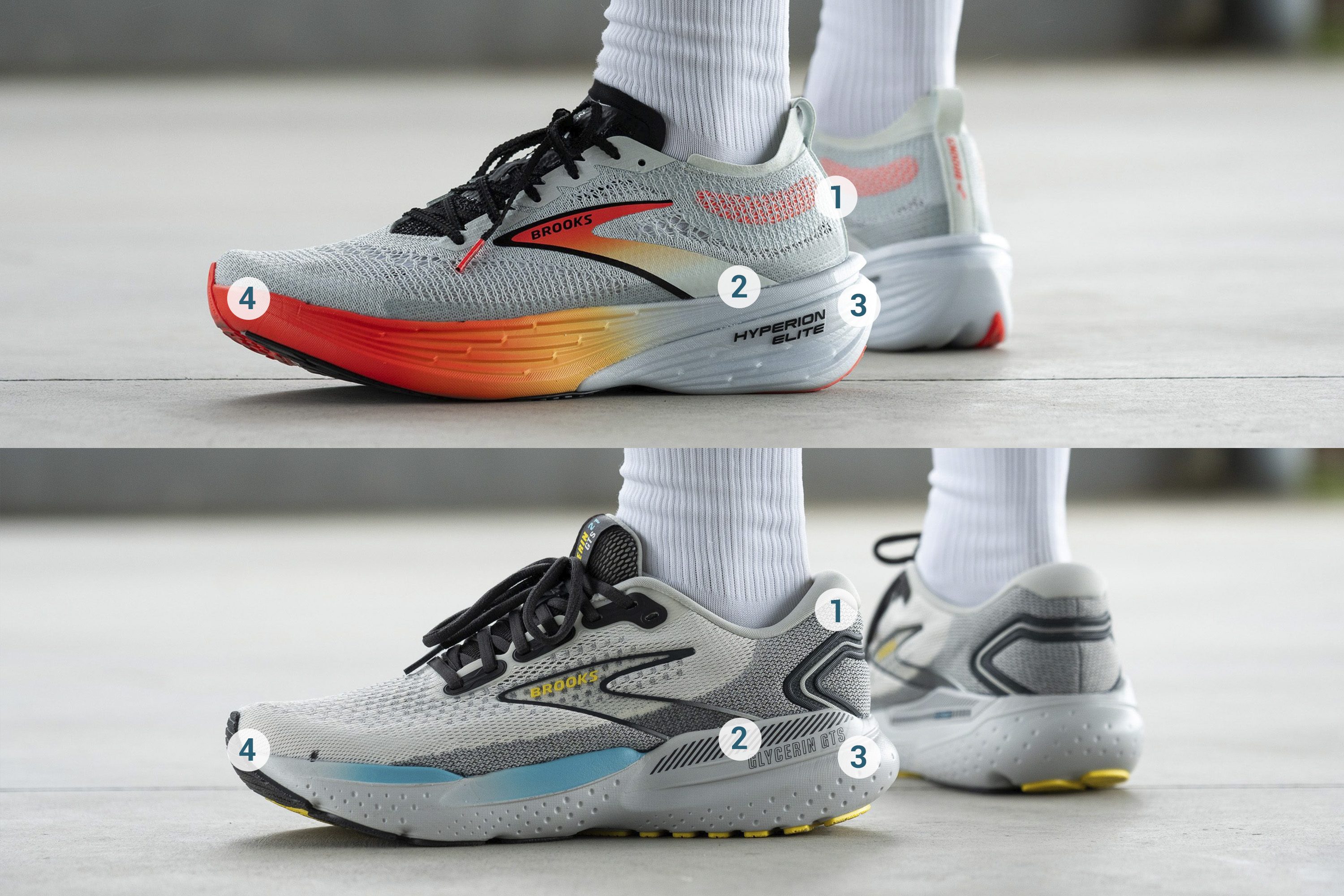
1) soft and very flexible heel vs. padded heel collar and stiff heel counter
2) no side walls vs. present sidewalls or GuideRails technology
3) tall and narrow base vs. tall and wider base with heel flare
4) less rubber coverage vs. more ground contact with the outsole surface
Overpronation running shoes use different technologies to stabilize the foot of those who overpronate. This is can be done in 2 ways:
- using different geometry elements when designing the shoe
- using trademarked technologies that brands develop.
Geometry elements used in overpronation running shoes
Dual-density midsole: often, we see midsoles of different densities combined in one shoe. The firmer midsole is found where support is needed - at the heel and under the arch or if the split is done horizontally, firmer foam sits closer to the ground while softer one is in contact with the foot to ensure a comfortable ride. We also see dual-density midsoles in Hoka's trademarked technologies called J frame and H frame.
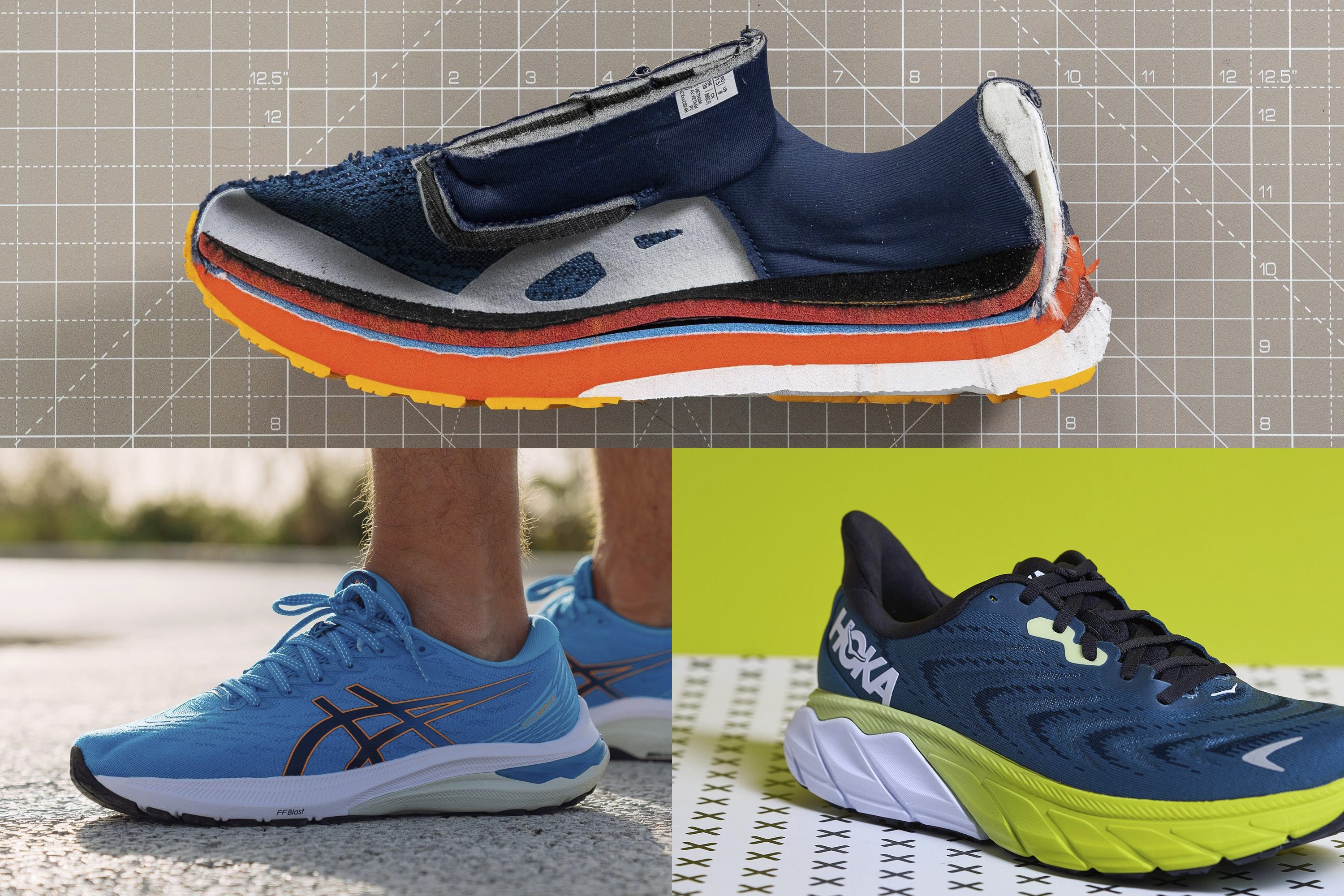
Medial post is made of denser foam or plastic and is located under the arch where it prevents the arch from collapsing and the ankle from rolling inward (to a certain degree). This technology was previously used much more, but today, we're seeing more dual-density midsoles and other elements that stabilize the foot.
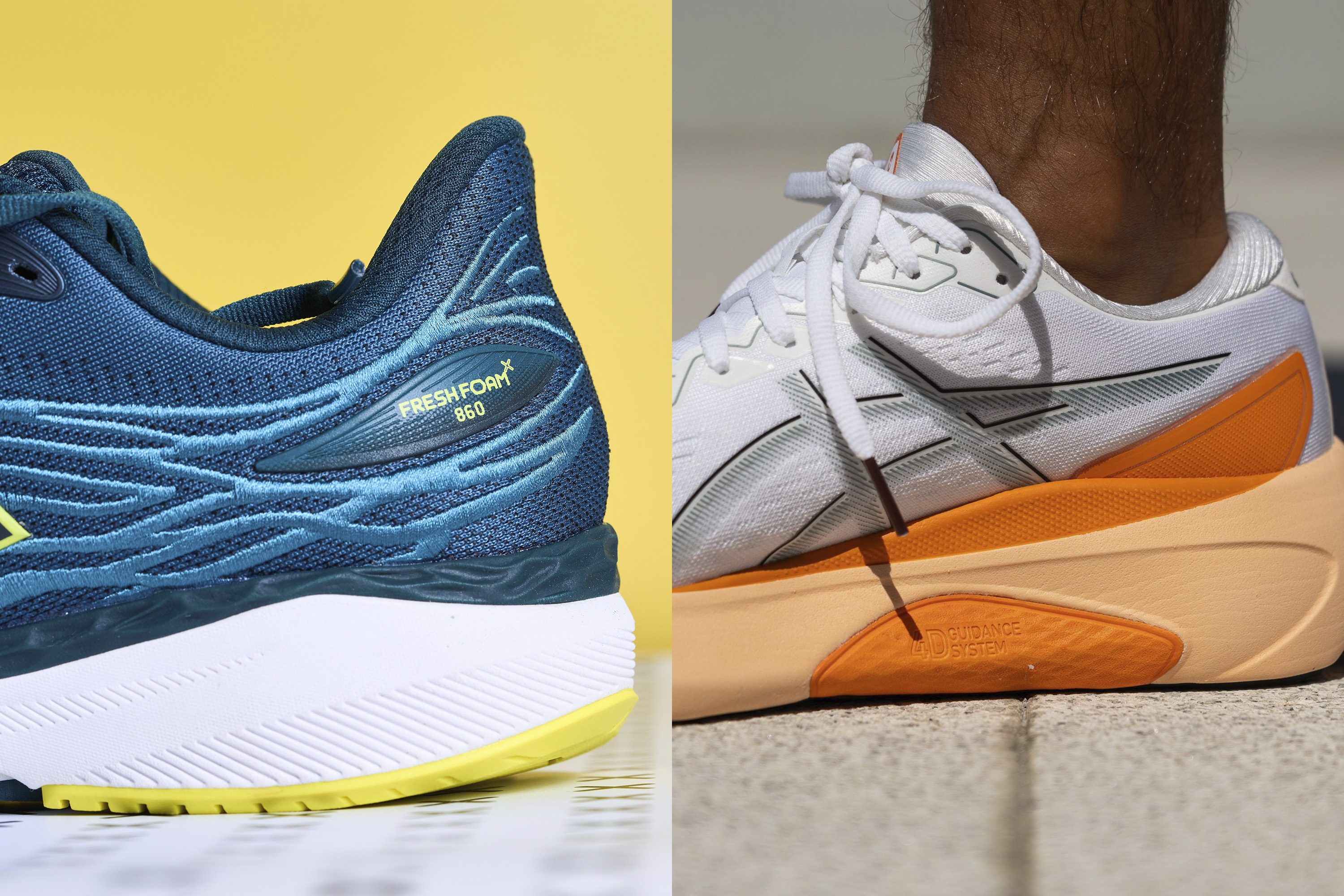
Stiff heel counter and padded heel collars. The stiffness of the heel counter allows for a heel to stay put and not to experience any unwanted movement. The padding cradles the heel and locks it in comfortably.
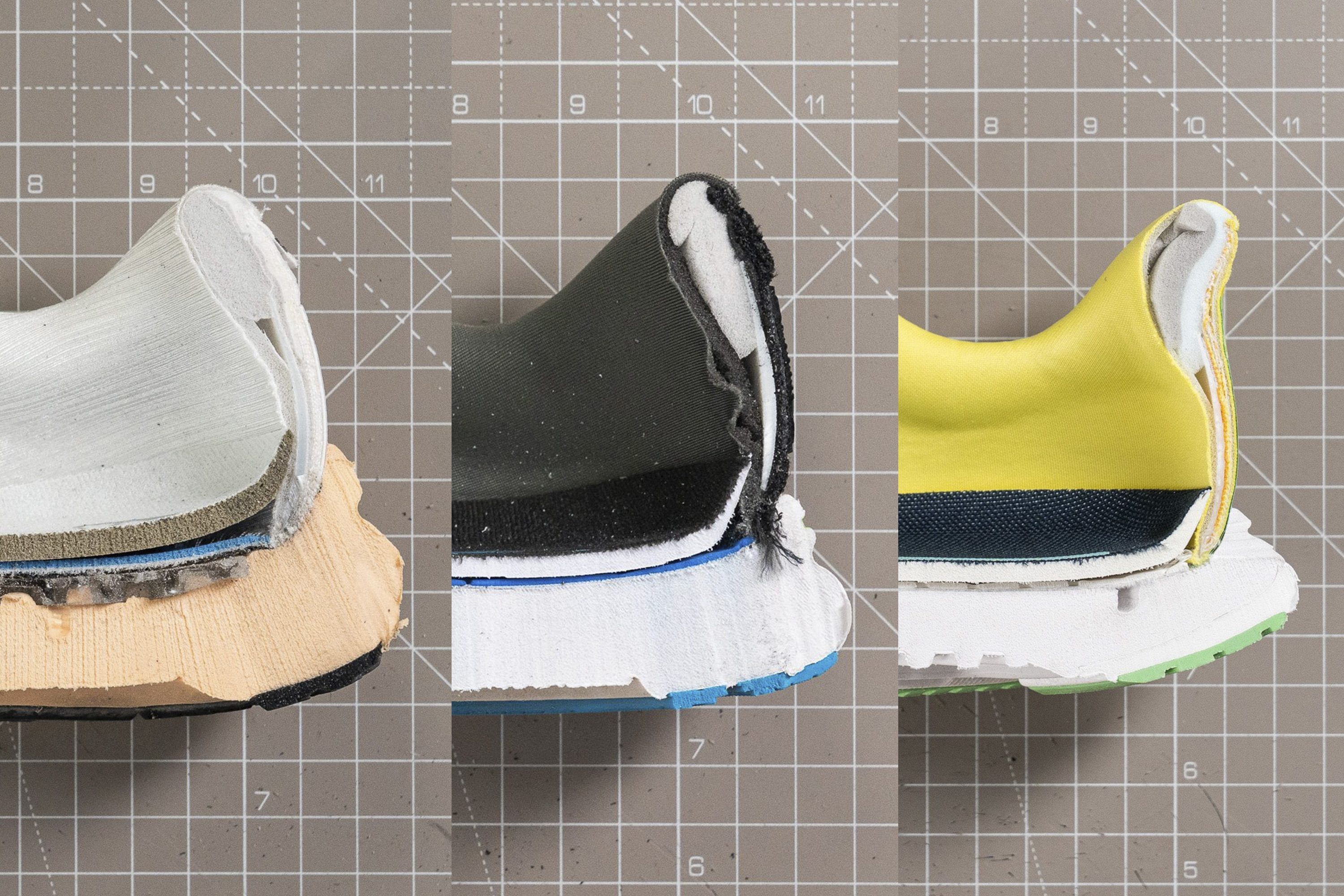
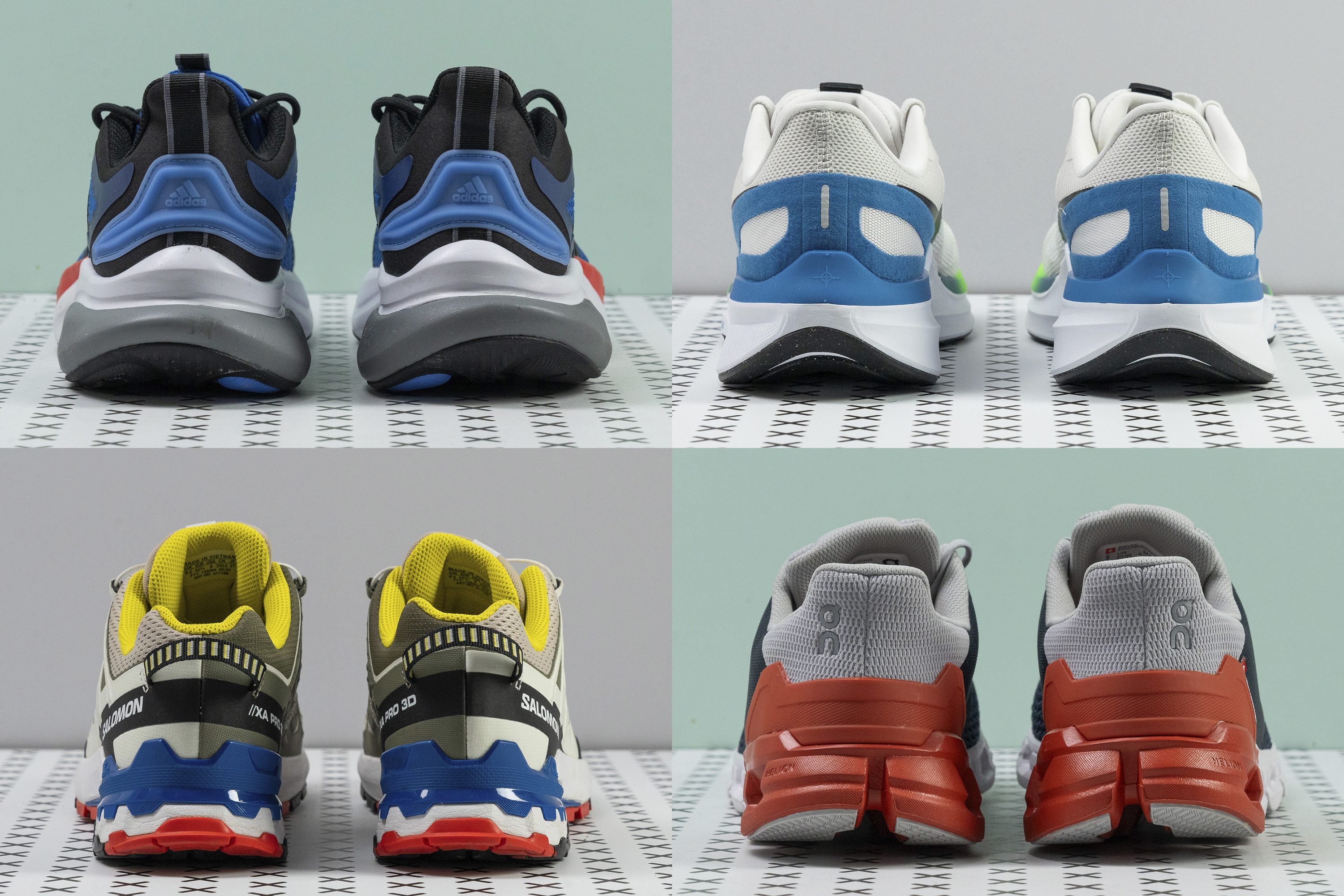
This is something that can be found in neutral shoes as well with the most extreme example found in premium race shoes who most often have a very soft, sock-like heel with basically no padding.
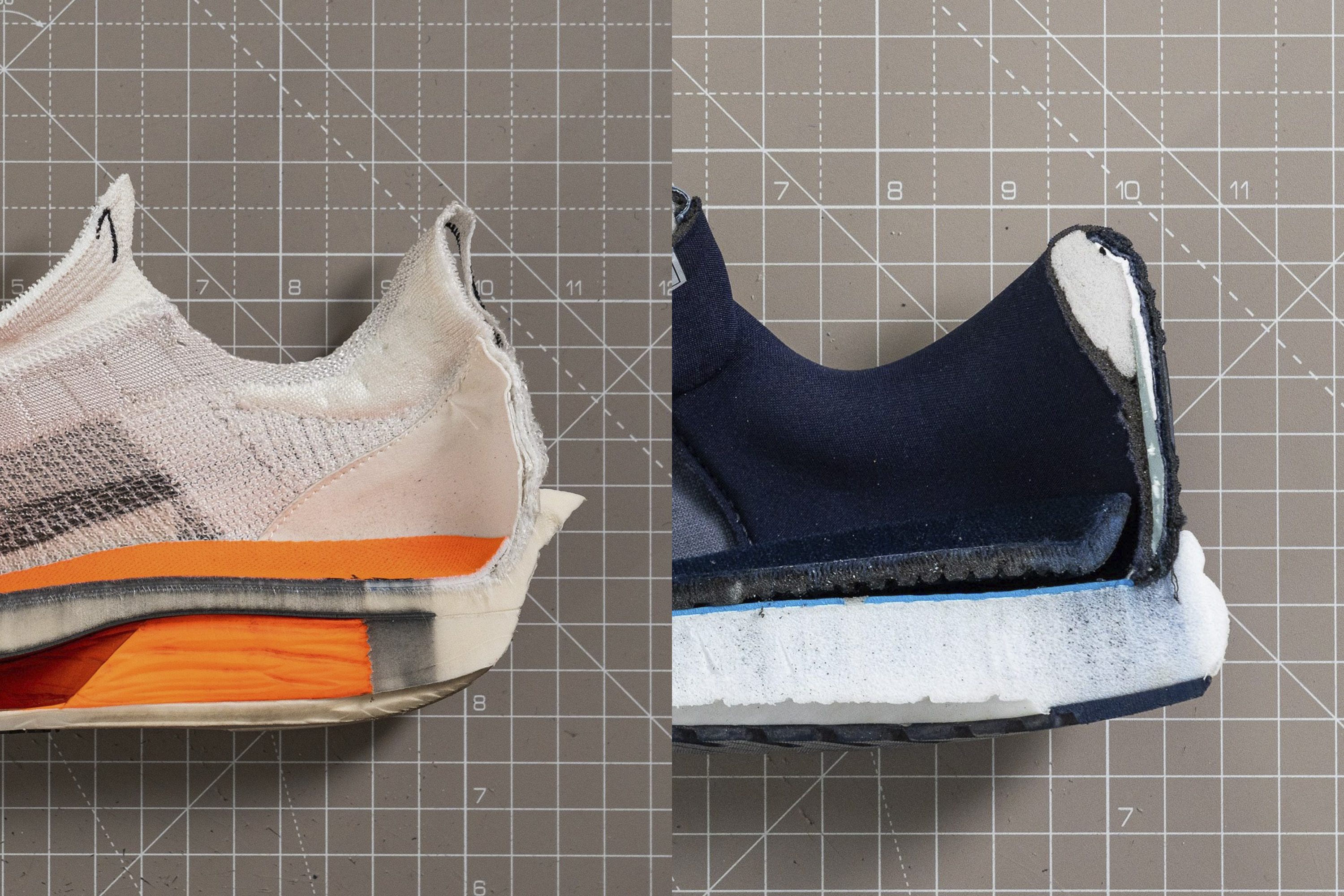
In our lab, we always assess the stiffness of the heel counter. We assign it a 1-5 rating where 5 is the stiffest.
For context, here's how stiff heel counters are in best-rated running shoes for overpronators:
Stiffer base which is often accomplished by having a firmer midsole or inserting plates or rods in the midsole.
To test this, we perform 2 tests: longitudinal and torsional.

When we bend the shoe to 30 degrees using a specialized machine, we take a note of the result. The higher the number in Newtons, the more force was needed to bend the shoe, which means a stiffer platform. Lower numbers mean more flexibility.
Torsional rigidity test done on an overpronation running shoe
When we twist the shoe, we assess its torsional rigidity. We give it a 1-5 rating, where 1 is the most flexible.
For context, here's how stiff (or flexible) best-rated overpronation running shoes are:
Wide base because that ensures planted landings unlike what we see in premium race shoes which are often tall and very narrow. Heel strikers prioritize the width of the midsole at the heel because it's there that they need extra stability.

In our lab, we use a digital caliper to measure the width of the base at the forefoot and at the heel.

In case you're curious about those that have the widest base, we've prepared this dynamic list that is updated with every new review that we publish (if the shoe gets a result that would make it a part of the list):
More ground contact is accomplished by having the outsole that touches the ground with a big percentage of its surface. What we have, on the other side of this spectrum, is a race shoe that can have huge chunks of outsole and midsole cut out, to decrease the weight and make the shoe more flexible.
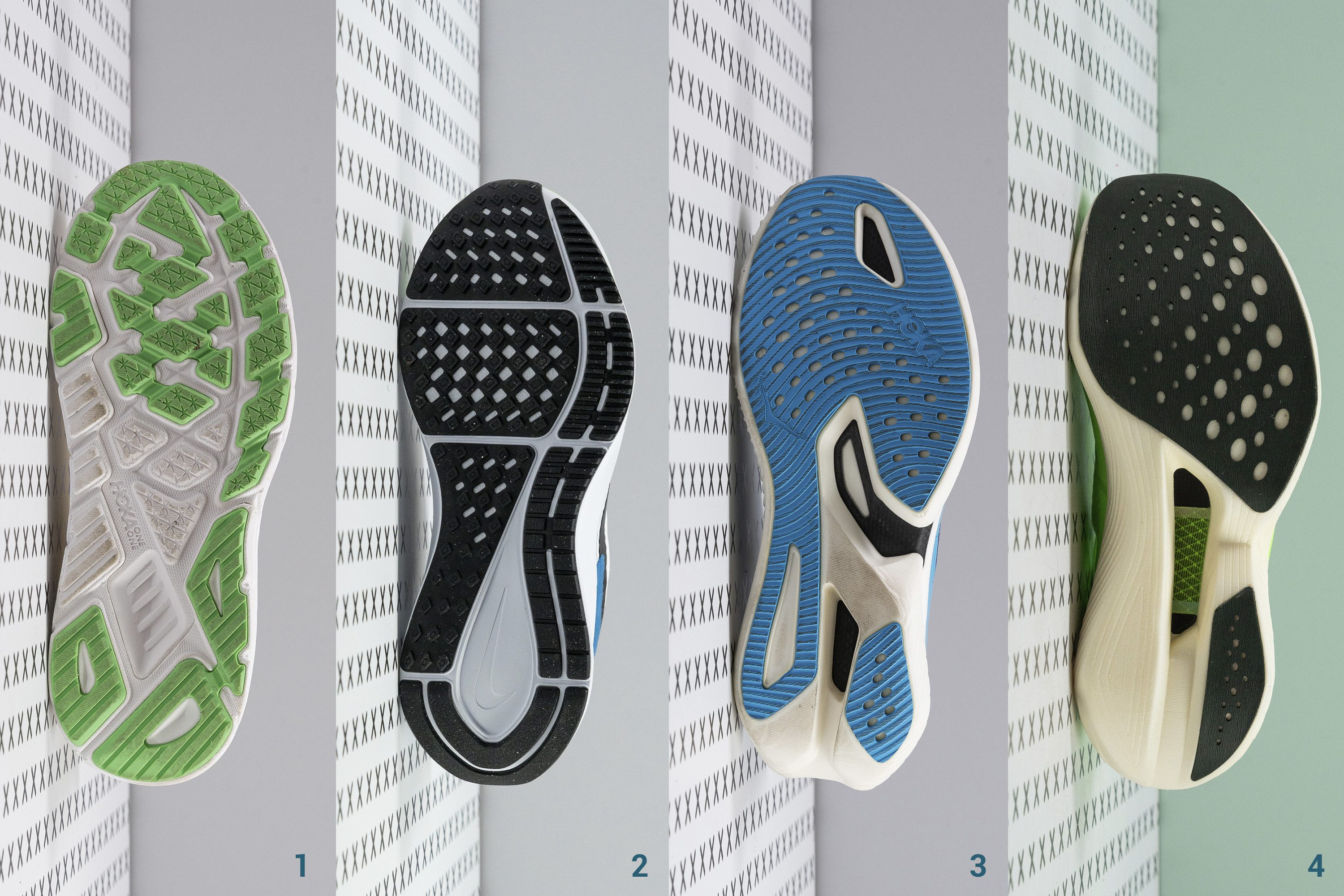
Sidewalls are midsole upward extensions that prevent unwanted side-to-side movement and that further stabilize the foot.

Heel bevel is very important for heel strikers because it imitates the shape of our heel bone which is curved as well. This curve eases the impact when the foot hits the ground and it improves the transition.
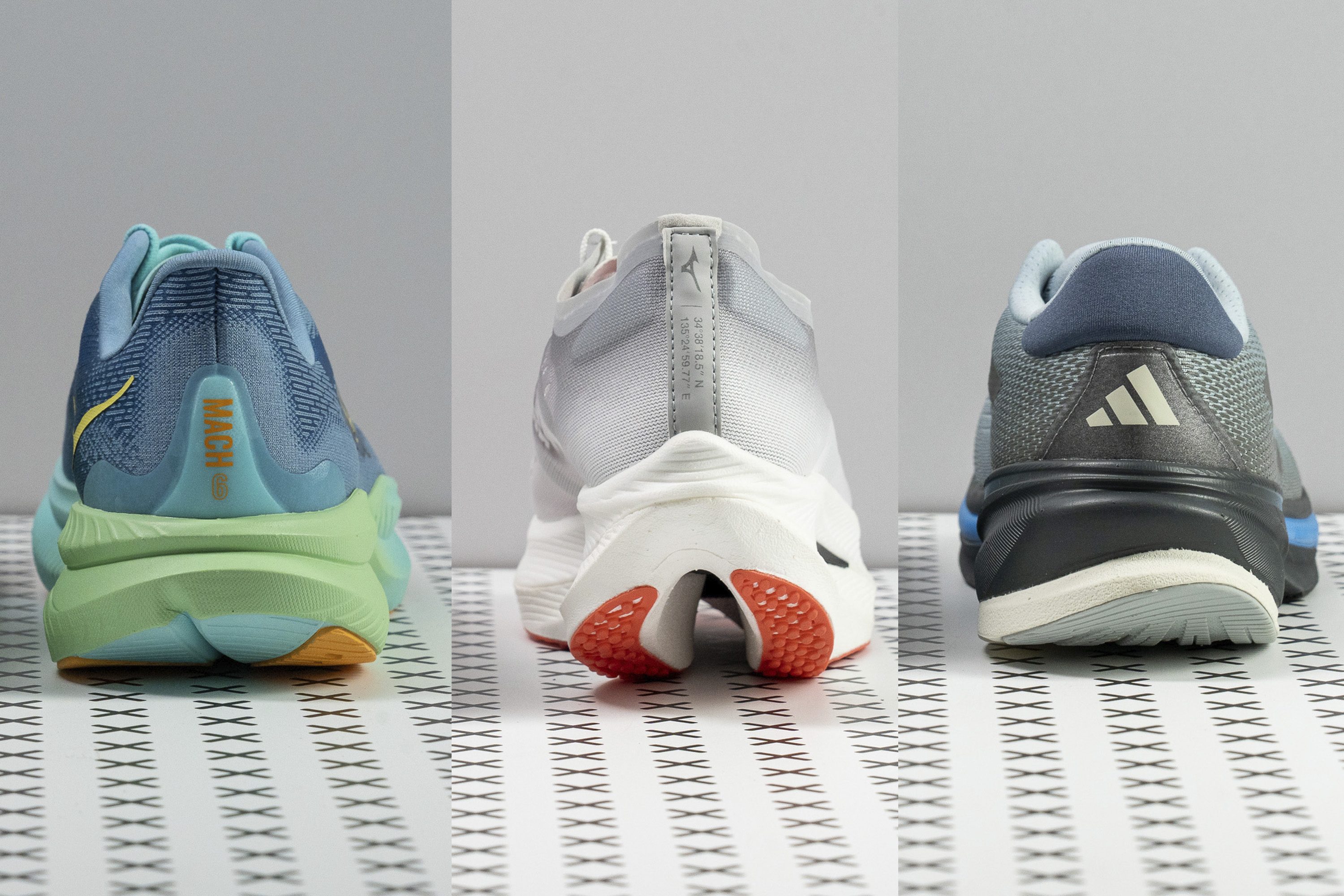
The opposite would be no heel bevel or having a straight, maybe even protruded heel, which could cause premature ground contact. This would result in an increased amount of stress in the tibialis anterior muscle.
Sole flare is a protrusion on the midsole that appears on the medial and/or lateral side of the shoe. It's a place where the midsole is wider than the upper.
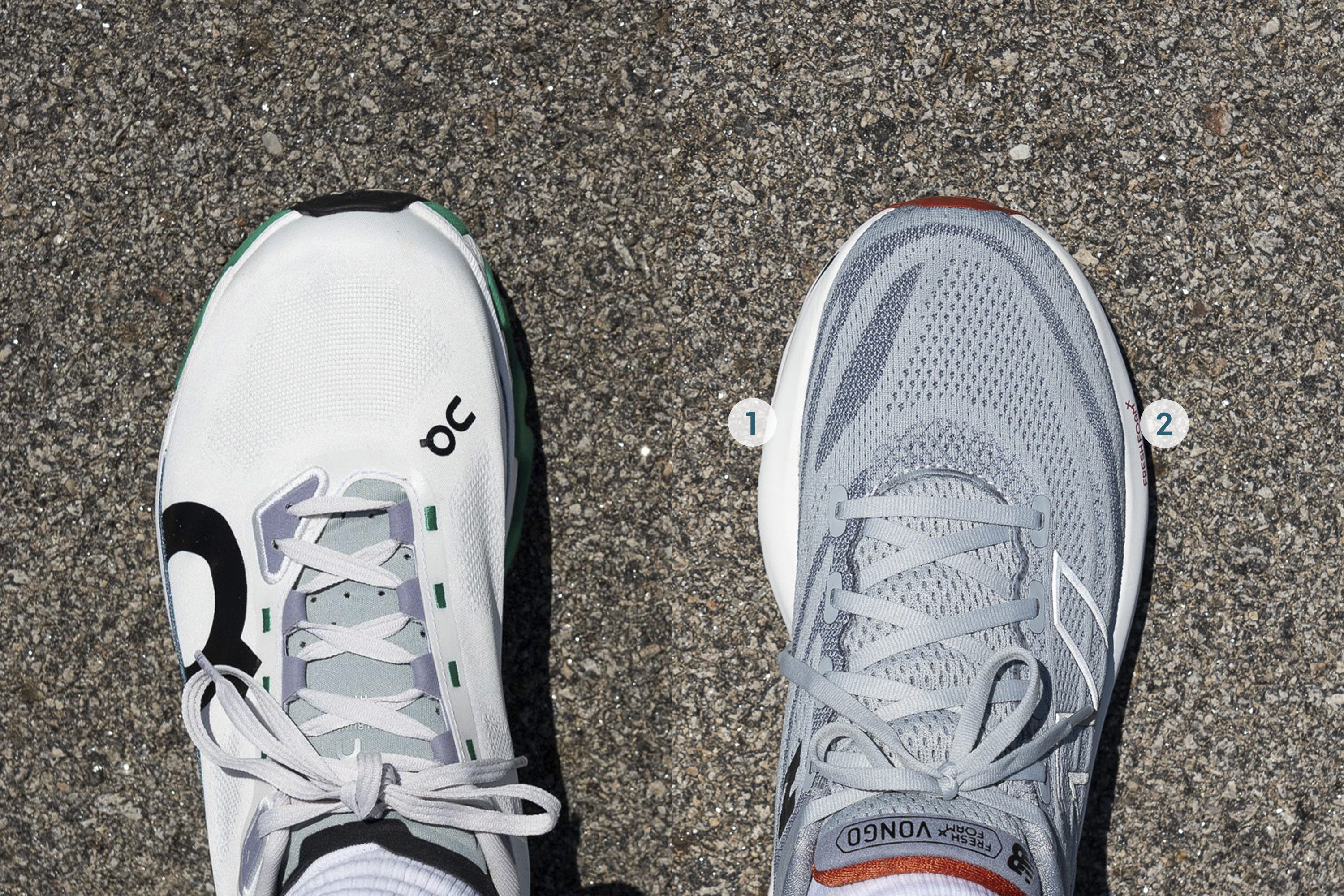
Heel strikers benefit a lot from a heel sole flare. Runners who pronate at the forefoot appreciate the medial forefoot flare.
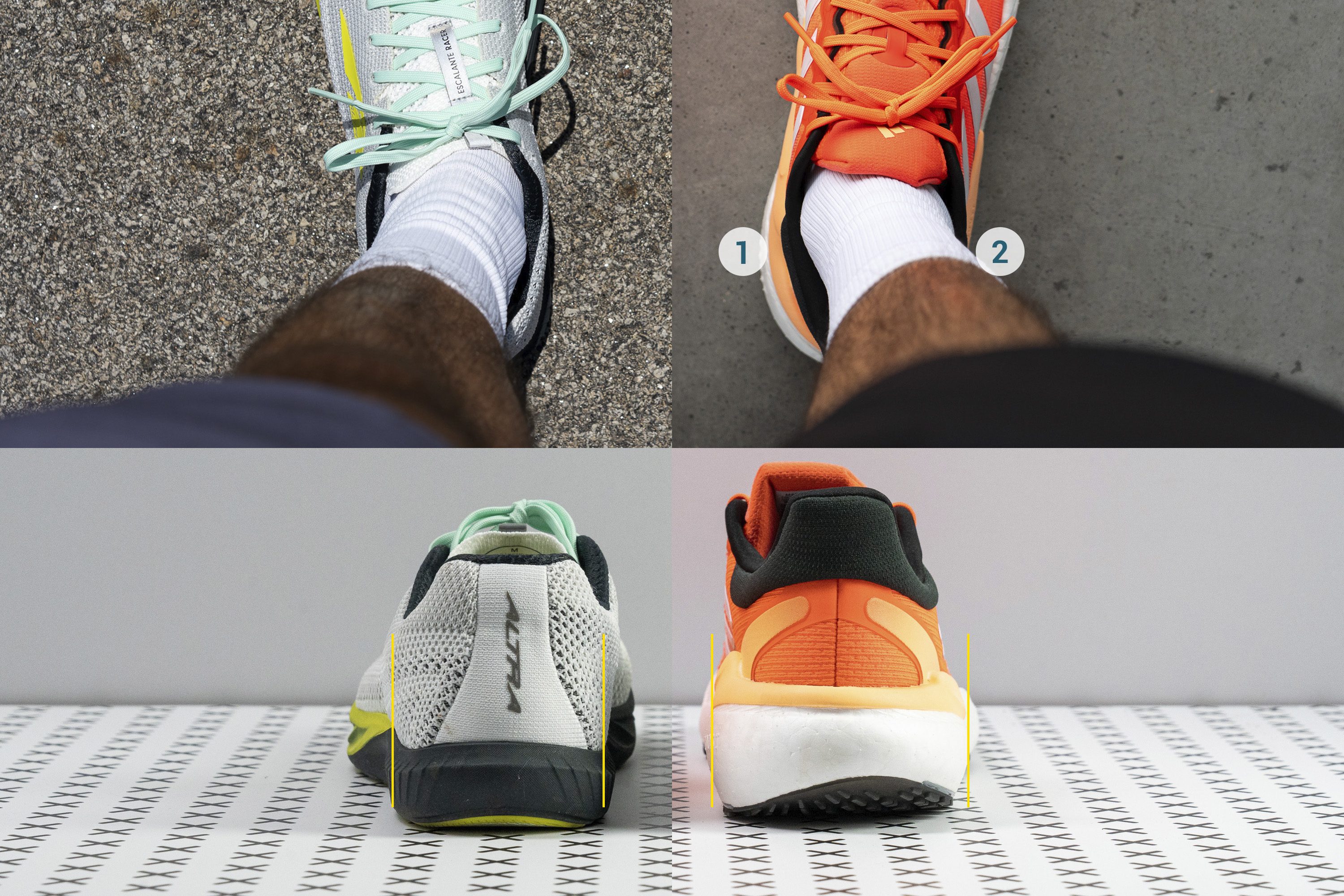
Structural upper overlays are made of stiffer materials, such as synthetic or even plastic. They help with support and stability by ensuring a superb lockdown.
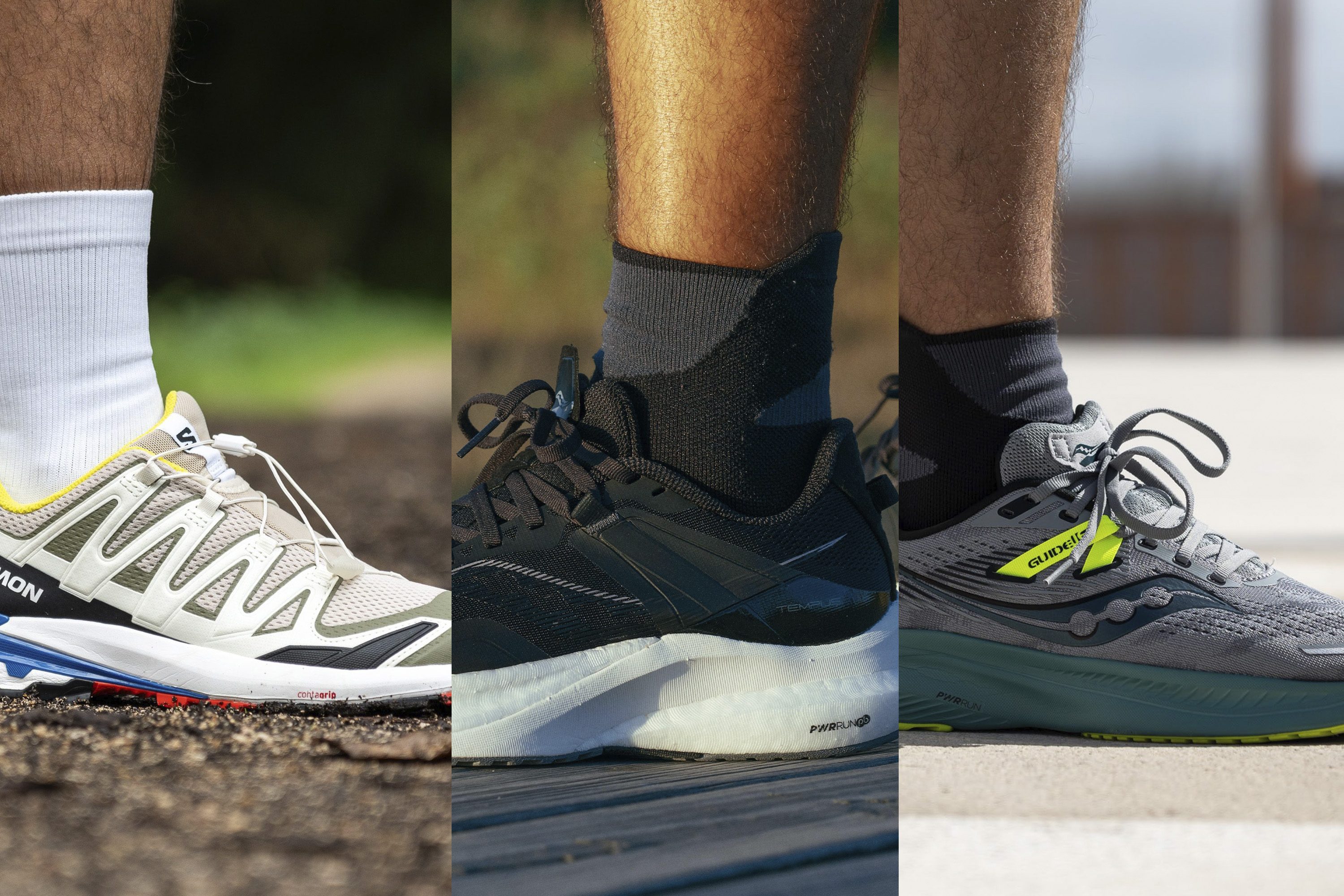
Trademarked technologies for stabilization in overpronation shoes
GuideRails by Brooks
GuideRails are made of two pieces of firmer foam on either side of the heel that look like walls. The inside piece reduces the rolling of the foot inward, and the outside piece is firmer and higher, stabilizing the heel by reducing its outward motion.
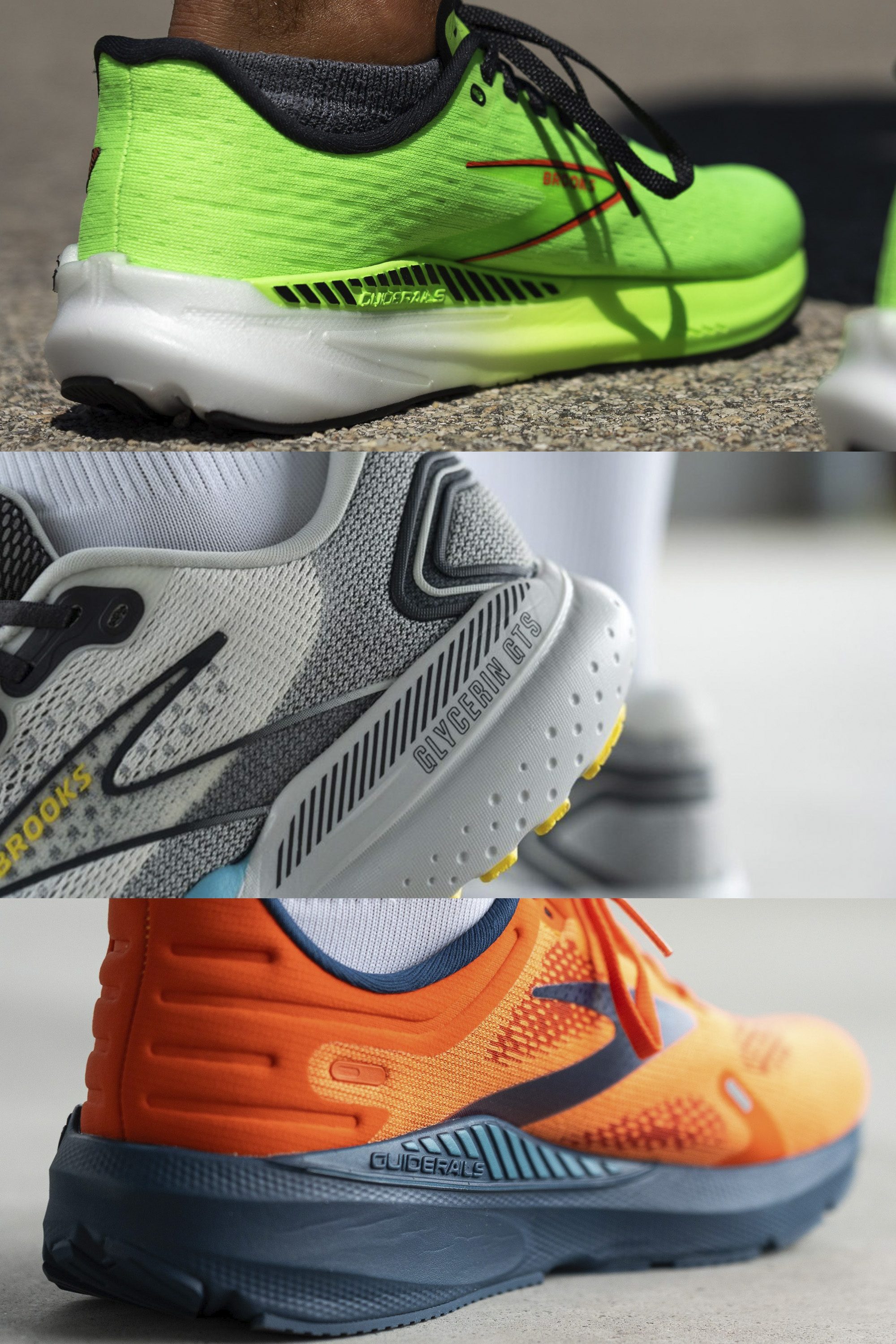
All the shoes from Brooks that utilize the GuideRails are overpronation running shoes. They have “GTS” (for go-to stability) in their name and they are easy to recognize as the newer models have the GuideRails design in stripes.
GuideRail by Altra
GuideRail from Altra focuses on the medial (inner) side, where the higher and firmer foam is placed for support.
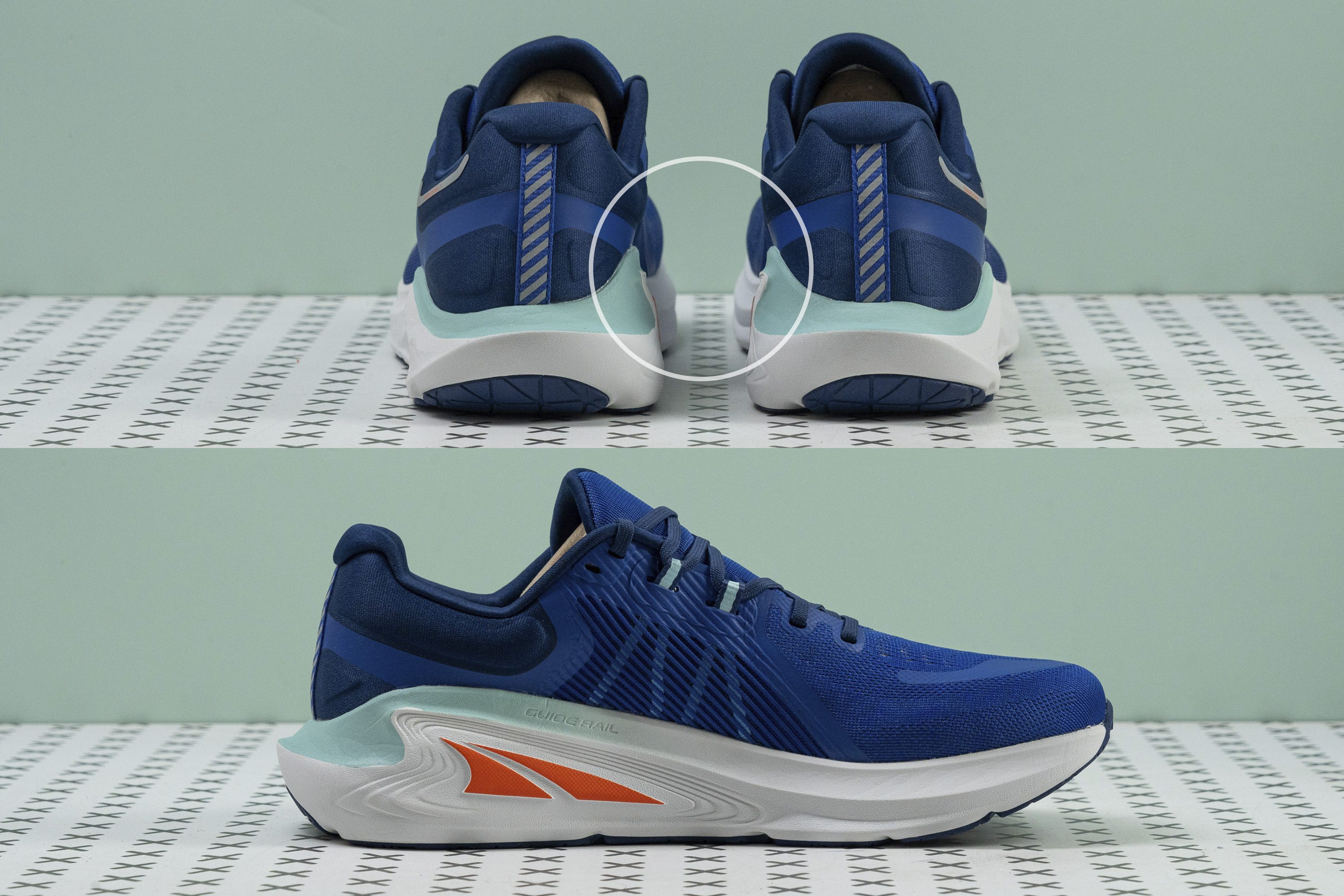
J-Frame by Hoka
J-shaped denser foam is a supportive structure with extended heel support. This foam goes around the heel and is often of different color than the rest of the midsole. In the colorway below, it is grey while the rest of the midsole is white.

H-Frame by Hoka
H-Frame is a support structure that they say is shaped like a letter H but it actually looks like a number 8. The shape of the 8 is made of firmer foam, and the cutouts allow the foot to be in direct contact with the plush foam, which results in a stable, soft shoe.
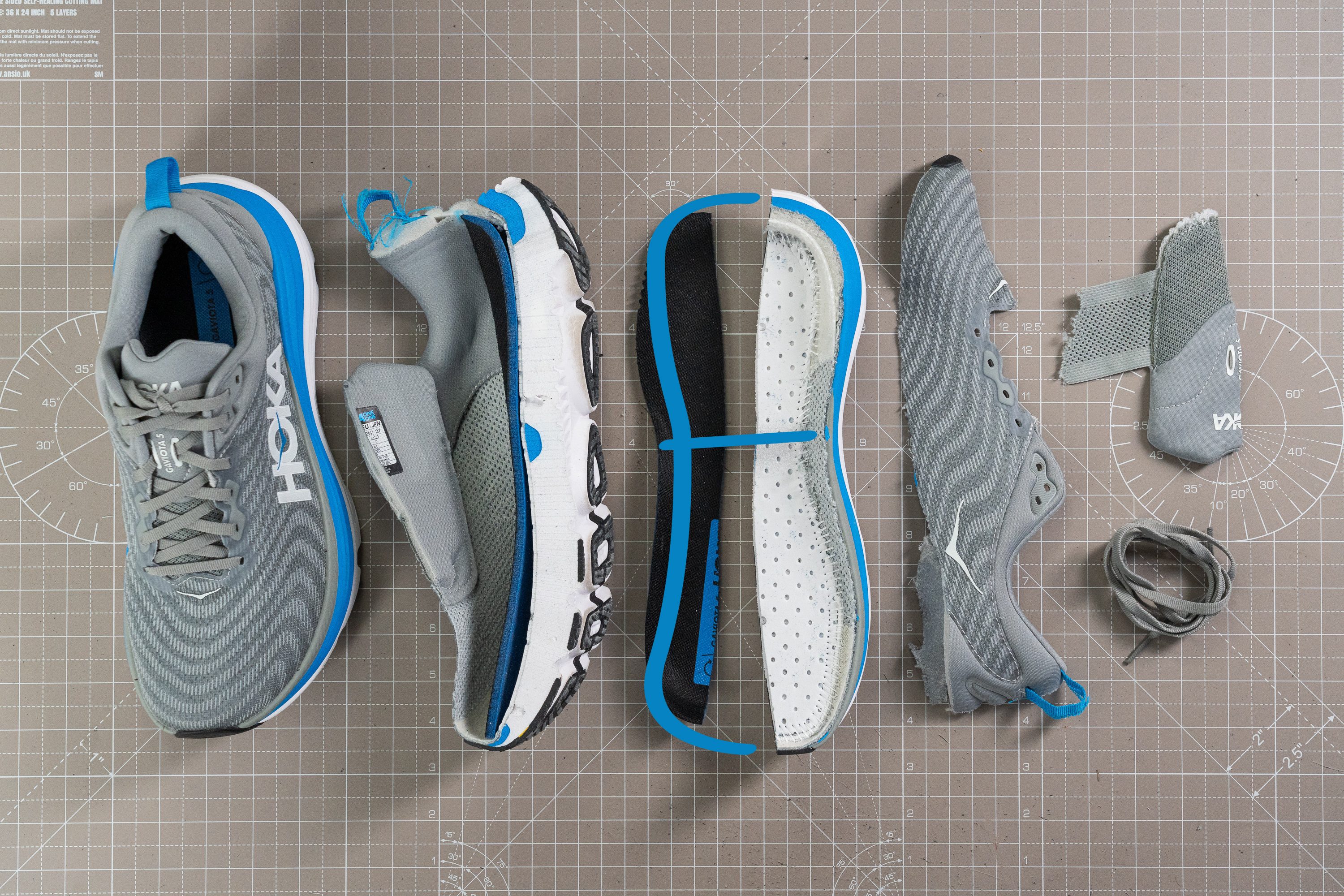
4D guidance system by Asics
This system includes 4 stabilizing elements:
- increased heel bevel
- sculpted midsole
- wider base
- medial post.
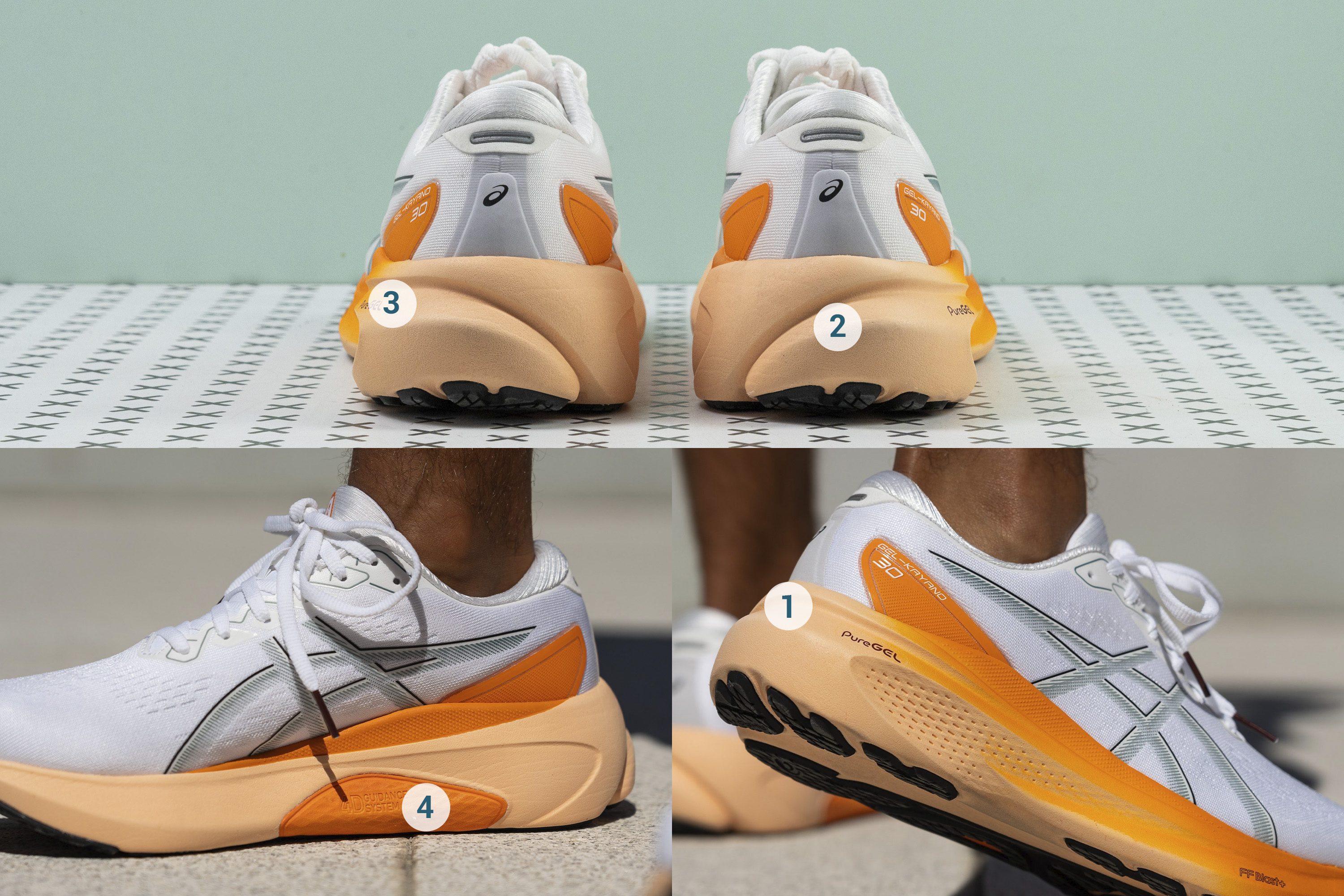
3D guidance system by Asics
3D guidance system contains stability elements:
- increased heel bevel
- wider base
- forefoot flare.
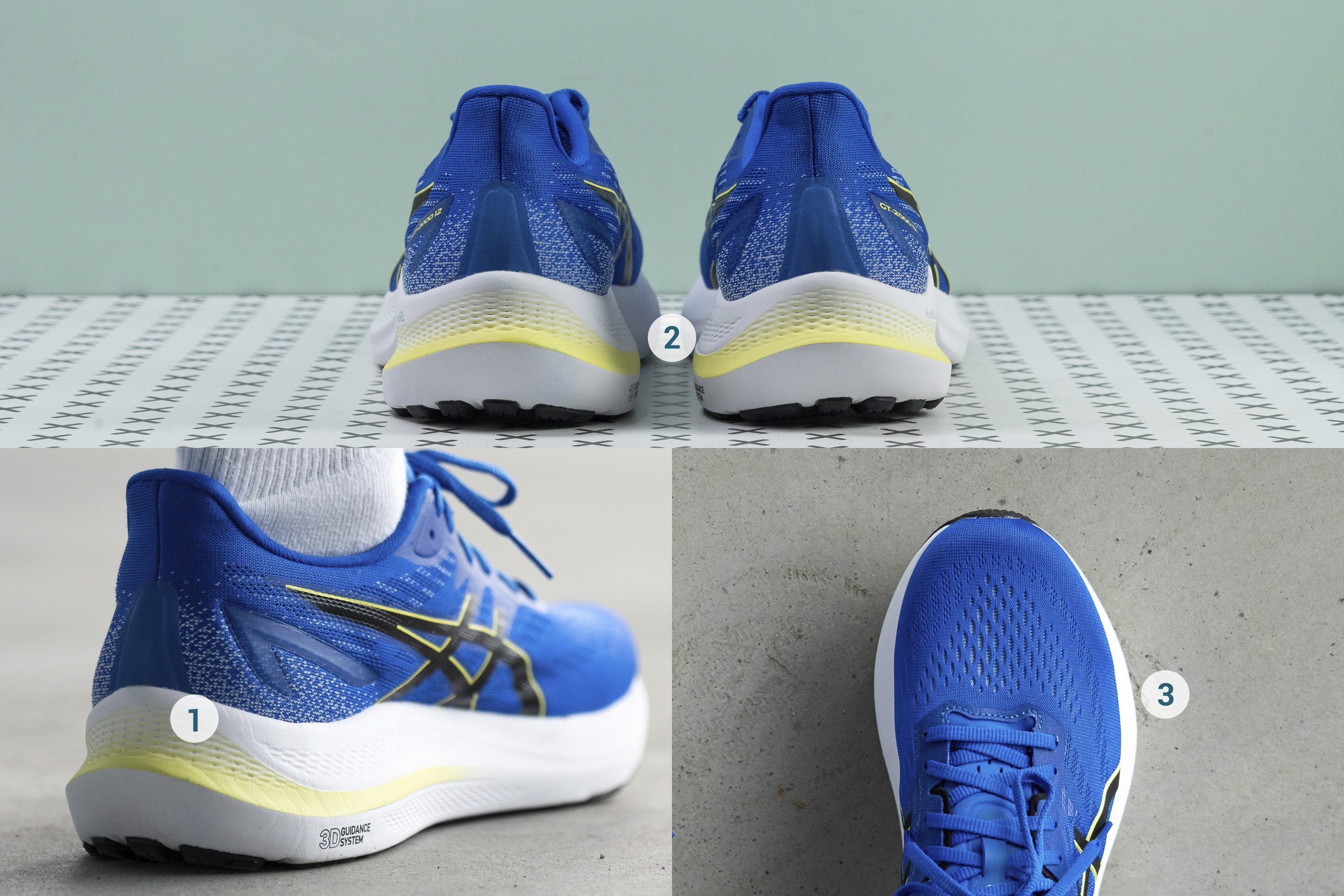
Mizuno’s Wave plate
This plate helps stop the arch from collapsing while offering stability. It’s easy to notice it on the shoe as it’s of a different color than the midsole.

There's also a variation of the Wave plate with a rubber wall and we can see it in Mizuno Wave Horizon 6:
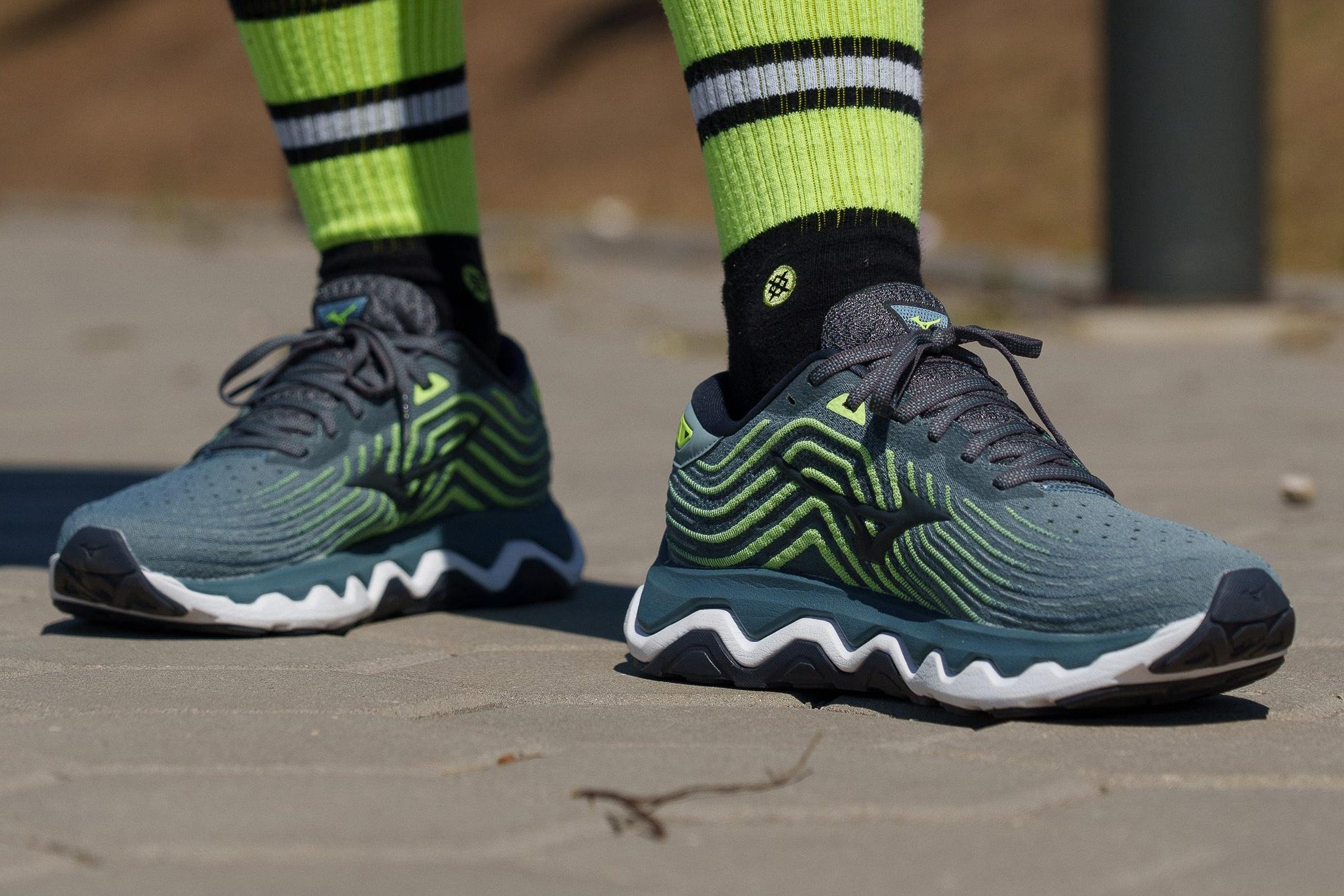
How heavy are overpronation running shoes
One of our lab tests is actually shoe weight. Sometimes, the numbers on our scale do not match the numbers from the brands' specifications. We always measure the weight of the shoe in men's US 9.
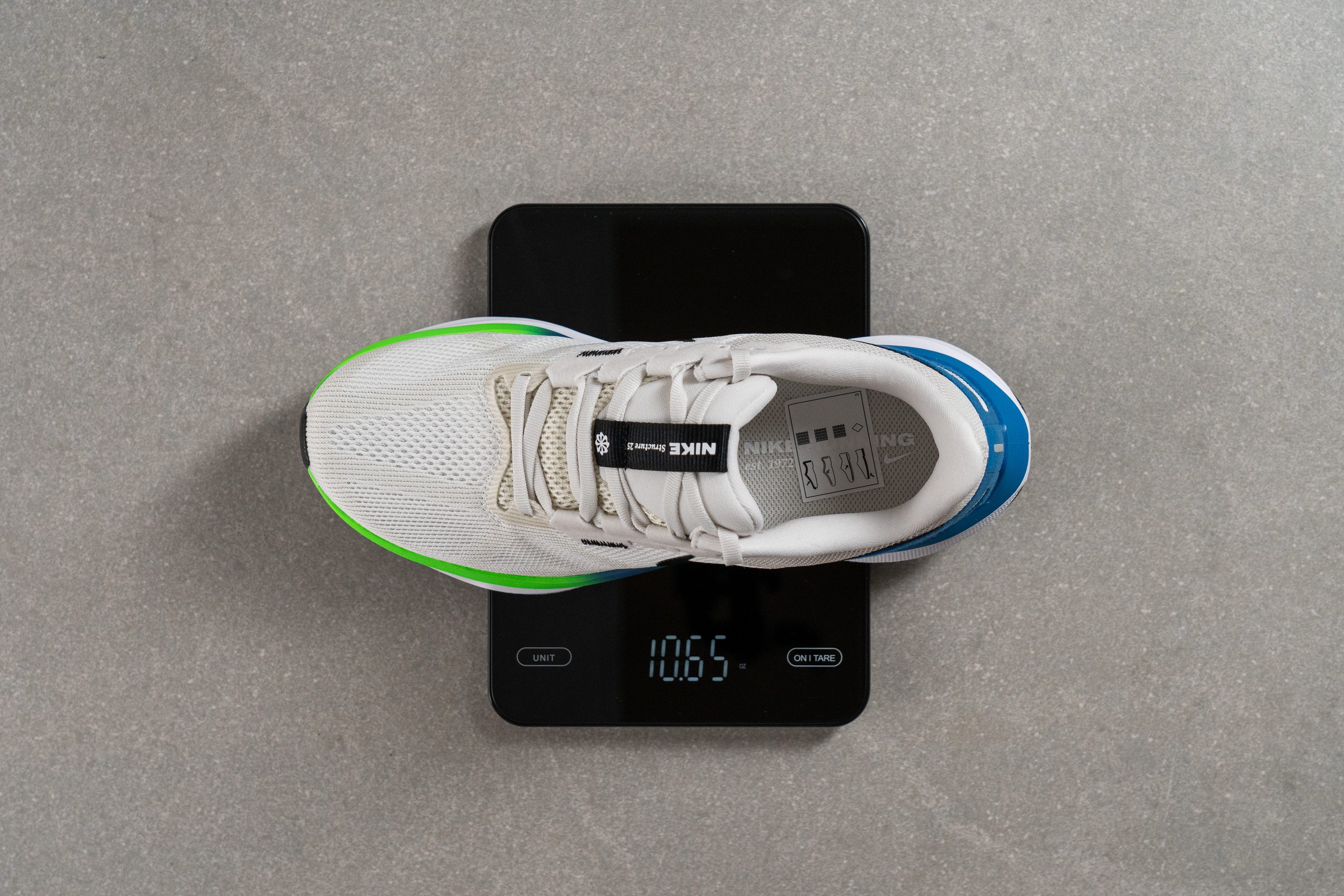
Because of all the stabilizing technologies that are implemented, overpronation running shoes tend to be heavier than neutral shoes. For context, have a look at the weights of best-rated overpronation running shoes:
In case you want them as light as possible, here's the list:
Softness and shock absorption of overpronation running shoes
Just because overpronation running shoes help with stabilization, it does not mean that they have to be firm. There are many overpronation shoes that are soft and we can thank new technologies for this because they are implemented together with a soft midsole to create a base that's good for overpronators.
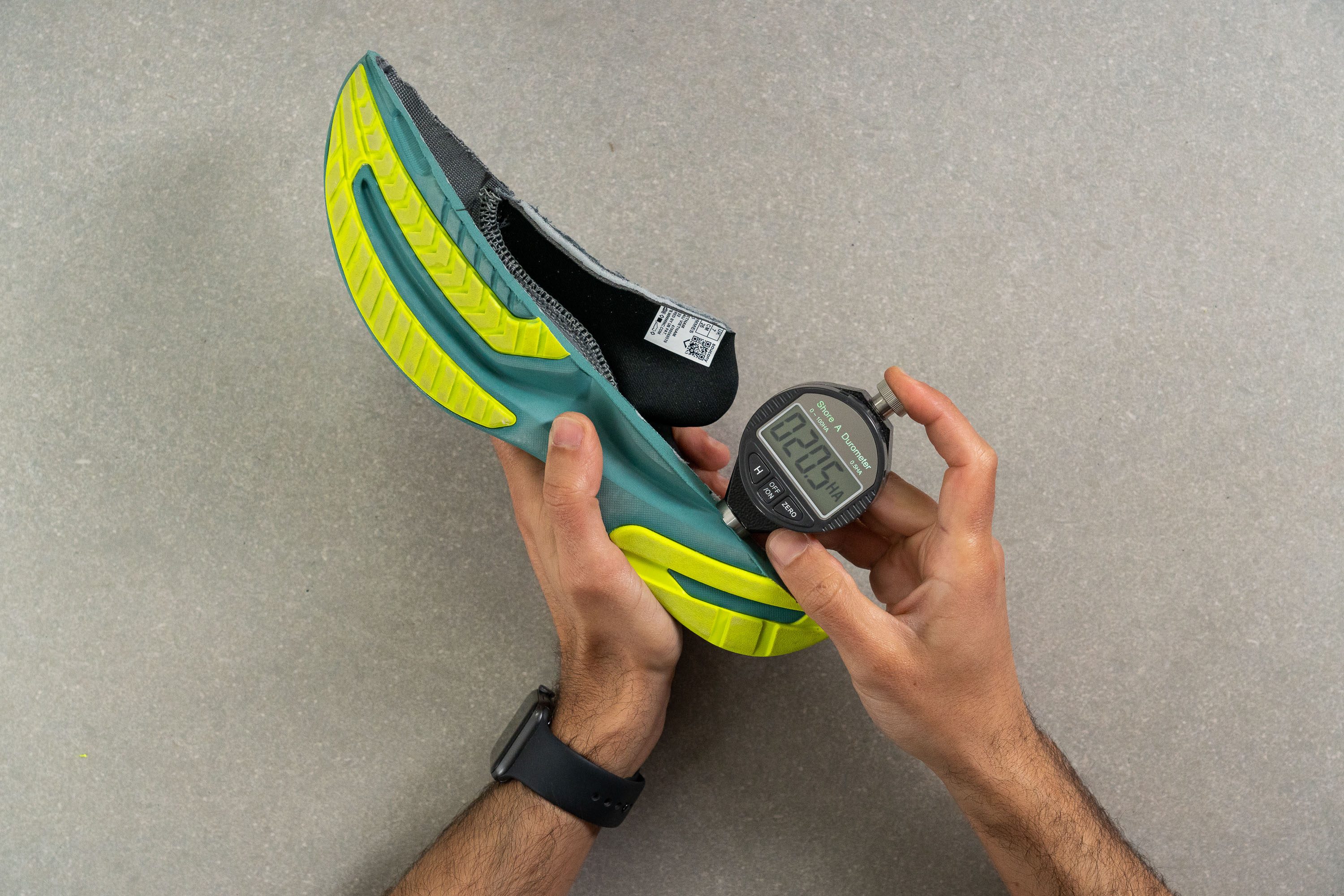
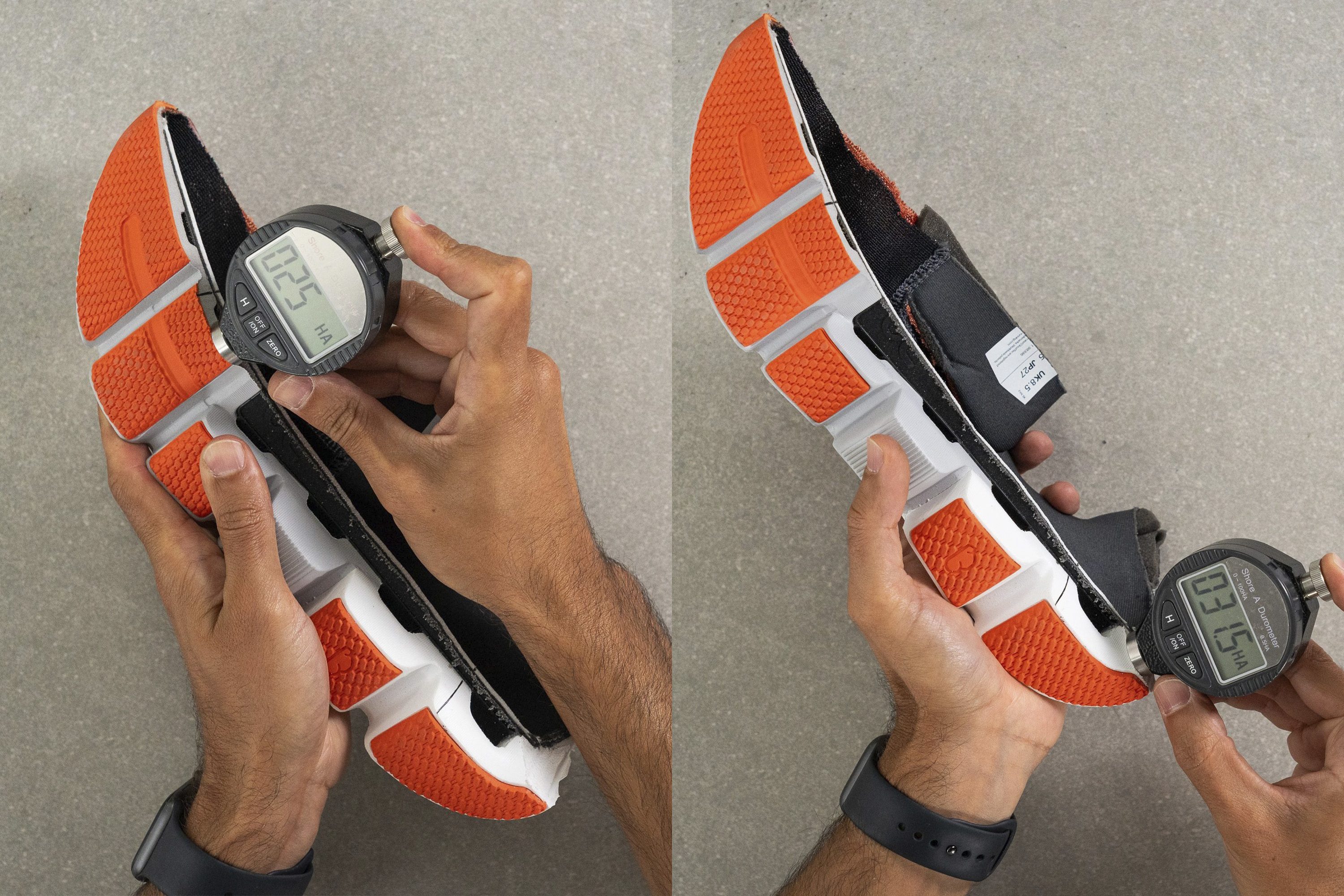
The lower the number on the durometer, the softer the foam. However, it's important to take into account shock absorption as well. Softness tells us just that: how soft the midsole is. Shock absorption, on the other hand, tells us how protective the midsole is, in terms of how good it is at dampening the impact that's happening at the landing. Ideally, the midsole will absorb as much of the impact as possible, so that it's not sent to the legs instead.
In the lab, we measure the shock absorption and energy return following the ASTM F1976-13 protocol
The results are given in SA and, the higher the number, the better. However, it's fair to say that the highest numbers can not be expected in stability daily trainers, which have other priorities in mind: stability and durability.
Energy return of running shoes for overpronation
Again, with stability as a priority, some runners may not think about energy return when choosing shoes for overpronation. But why not? It's such an important feature because it tells us how responsive the midsole is. Given that we're not talking about competition running shoes, these numbers don't have to be sky high, but there's no reason to settle for a shoe with the lowest energy return.
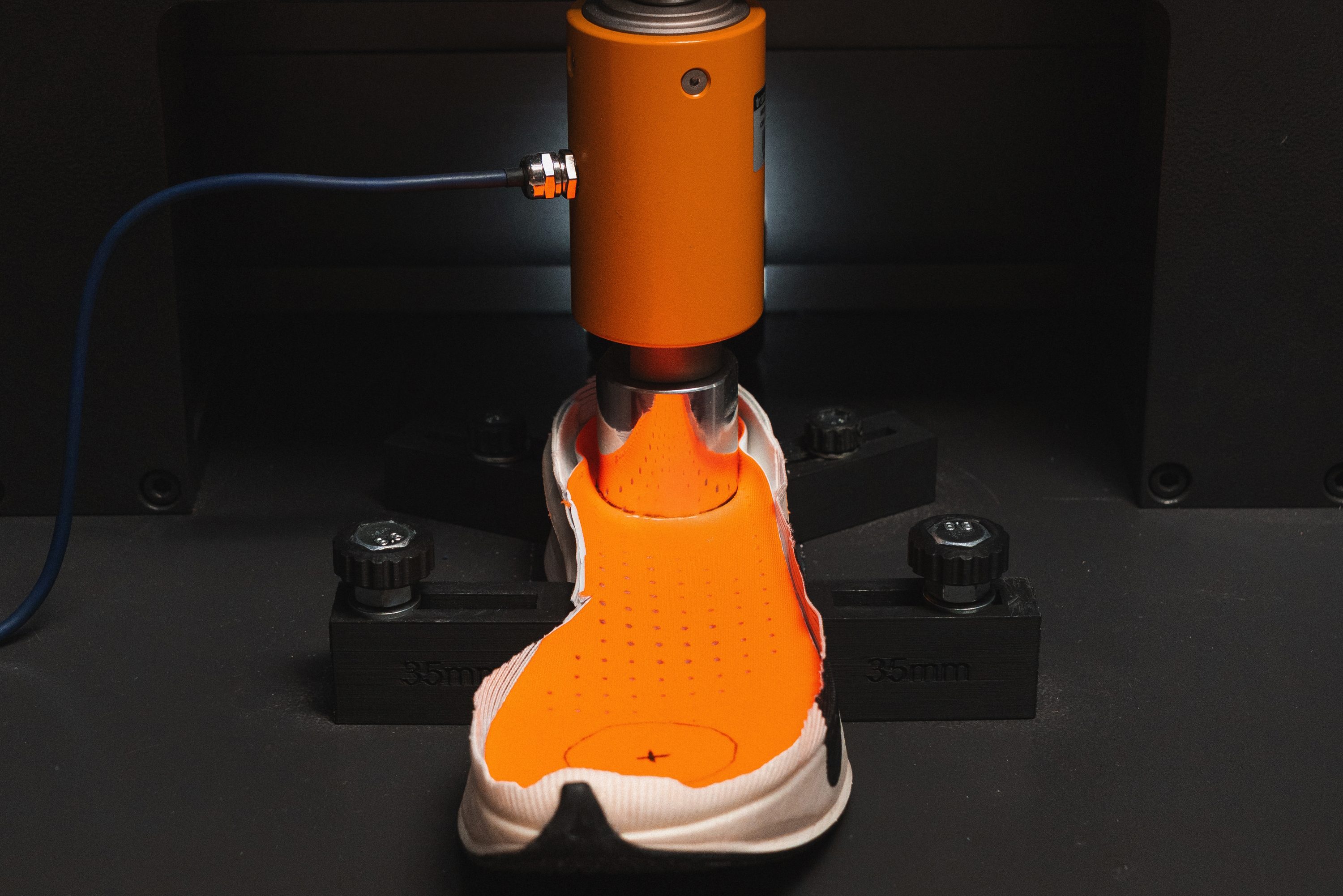
In fact, it's best to look at both shock absorption and energy return.
How durable are overpronation running shoes
Running shoes last less when landing is uneven because impact forces are stronger than when runners with neutral pronation land and use the shoe evenly. So, the durability of the shoes is a legitimate concern.
In our shoe lab, we look at the durability of the toebox, heel padding, and outsole.
Testing the durability of the toebox on an overpronation running shoe
After we've used our Dremel, we look at the damage and give it a rating on a 1-5 scale. 1= least durable, 5= most durable.
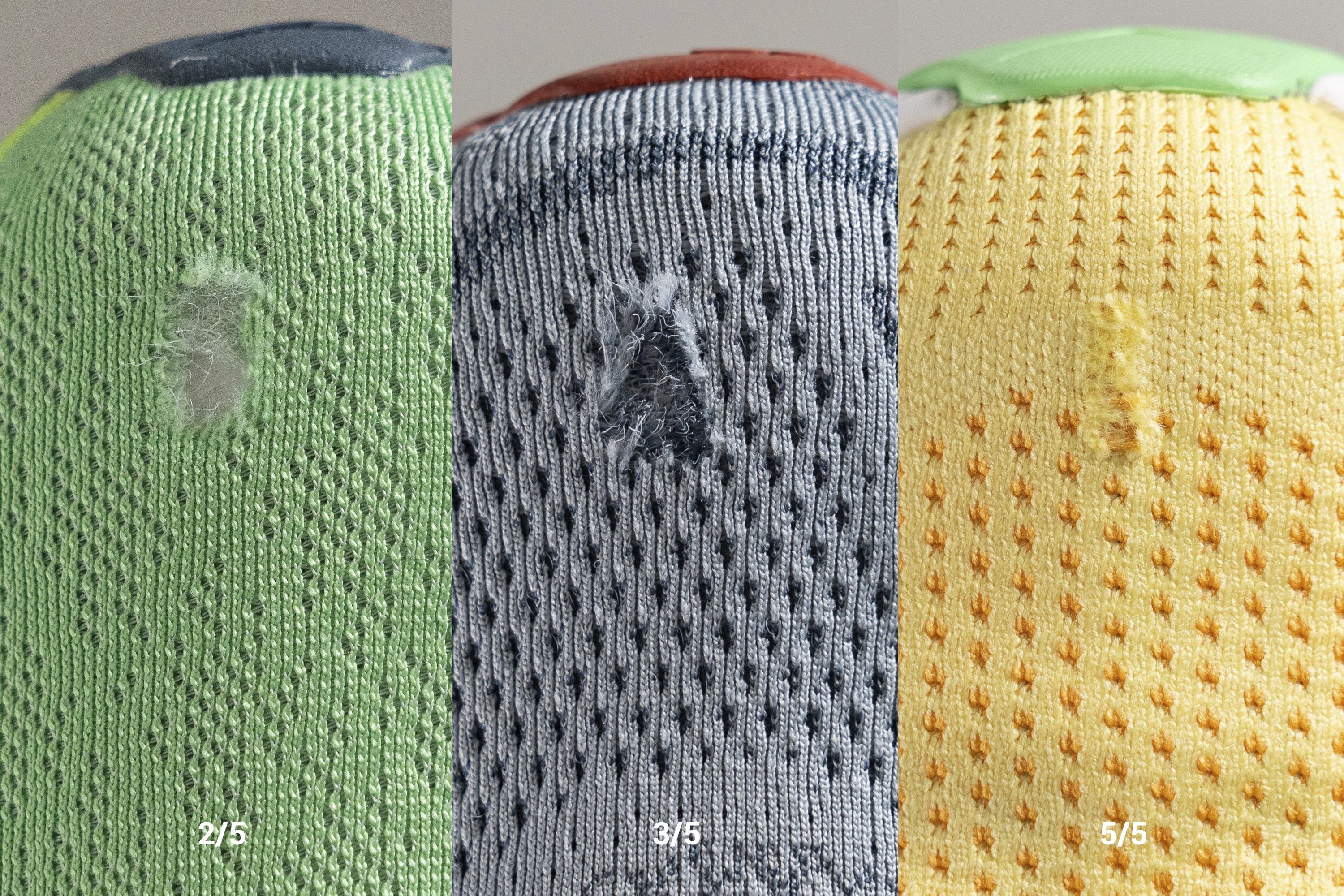
Toeboxes with no overlays are less durable, just like knit is less durable then, say, mesh.
Testing heel padding durability in RunRepeat lab
Here we again assess the damage on a 1-5 scale, where 5 is the most durable.

Testing outsole durability with a Dremel
When it comes to the outsole durability, we don't assess the damage but measure it precisely using a tire tread gauge. The deeper the dent, the less durable the outsole.

If you prioritize durability, here's an overview of most durable outsoles in overpronation running shoes:
Why stable neutral shoes are most likely not enough for overpronators
They can be if pronation is very mild. Simply because there are some neutral shoes that are very stable.
But, if pronation is moderate or severe, neutral shoes do not offer enough stabilization.
|
Overpronation (stability) shoes |
Stable neutral shoes |
|
Both can have a wider base, heel flare, … |
|
|
Only overpronation shoes have GuideRails, GuideRail, J frame, H frame, etc. |
|
|
Both can work for mild pronation, depending on how mild. |
|
|
Best for moderate overpronation. |
Best for neutral pronation. |
|
Usually stiffer than neutral running shoes |
Usually more flexible and softer than stability shoes |


